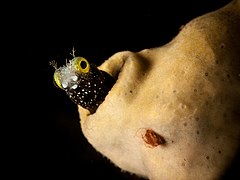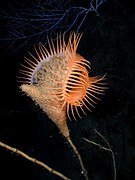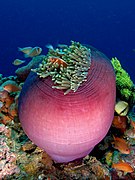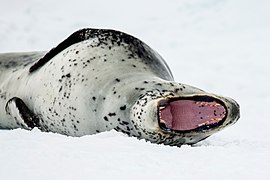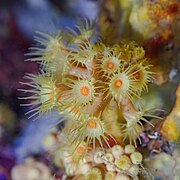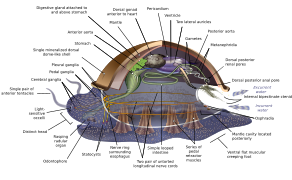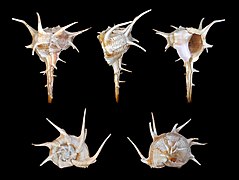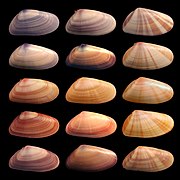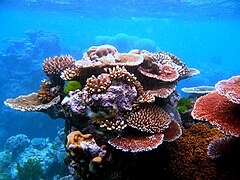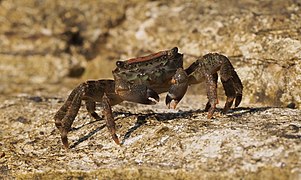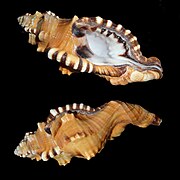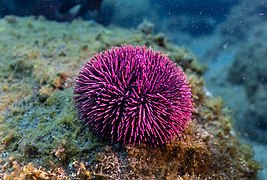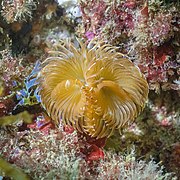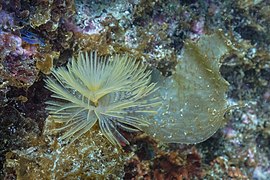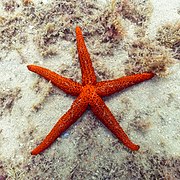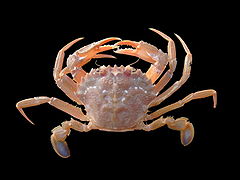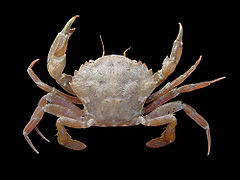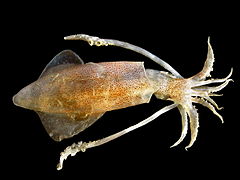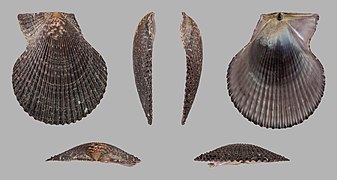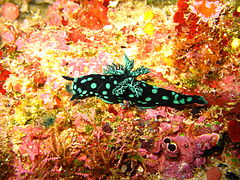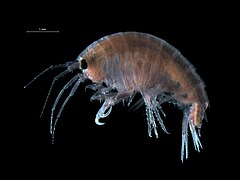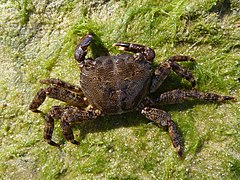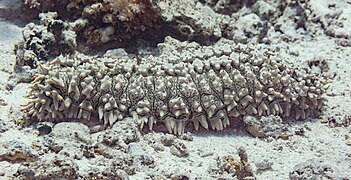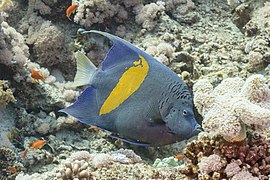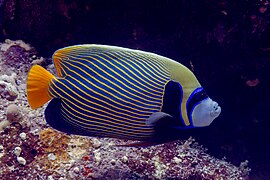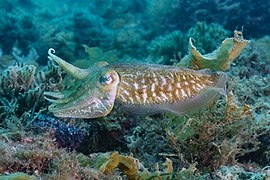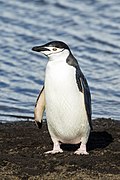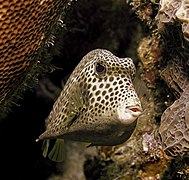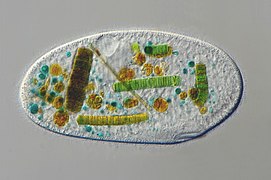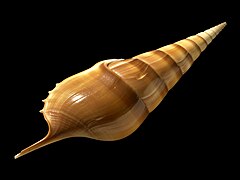Wikipedia:WikiProject Marine life/Recognized content
Appearance
| This is a list of recognized content, updated weekly by JL-Bot (talk · contribs) (typically on Saturdays). There is no need to edit the list yourself. If an article is missing from the list, make sure it is tagged (e.g. {{WikiProject Marine life}}) or categorized correctly and wait for the next update. See WP:RECOG for configuration options. |
 Featured articles
Featured articles
[edit] Acamptonectes
Acamptonectes Baleen whale
Baleen whale Bivalvia
Bivalvia Blue whale
Blue whale Humpback whale
Humpback whale Livyatan
Livyatan Manta ray
Manta ray Octopus
Octopus Orca
Orca Pinniped
Pinniped Queen angelfish
Queen angelfish Right whale
Right whale Sea mink
Sea mink Sea otter
Sea otter Starfish
Starfish Steller's sea cow
Steller's sea cow
Total pages in content type is 16
 Former featured articles
Former featured articles
[edit]Total pages in content type is 4
 Featured lists
Featured lists
[edit]Total pages in content type is 2
 Good articles
Good articles
[edit] Anthozoa
Anthozoa Archelon
Archelon Barnacle
Barnacle Bathyphysa conifera
Bathyphysa conifera Bigfin reef squid
Bigfin reef squid Black coral
Black coral Bottlenose dolphin
Bottlenose dolphin Brachiopod
Brachiopod Cafileria
Cafileria Cartorhynchus
Cartorhynchus Cnidaria
Cnidaria Coral
Coral Corallivore
Corallivore Crinoid
Crinoid Crustacean
Crustacean Ctenophora
Ctenophora Deep biosphere
Deep biosphere Dugong
Dugong Dusky dolphin
Dusky dolphin Dyspanopeus sayi
Dyspanopeus sayi Echinoderm
Echinoderm Echiura
Echiura False killer whale
False killer whale Fin whale
Fin whale Halfbeak
Halfbeak Stephen Hillenburg
Stephen Hillenburg Horseshoe crab
Horseshoe crab Jellyfish
Jellyfish Kimberella
Kimberella Life
Life Malacostraca
Malacostraca Marine mammal
Marine mammal Millepora alcicornis
Millepora alcicornis Monk seal
Monk seal Monterey Bay Aquarium
Monterey Bay Aquarium Mysida
Mysida Narwhal
Narwhal Nemertea
Nemertea Orcinus meyeri
Orcinus meyeri Phoronid
Phoronid Scaly-foot gastropod
Scaly-foot gastropod Scleractinia
Scleractinia Sea anemone
Sea anemone Sea snake
Sea snake Sea urchin
Sea urchin Sei whale
Sei whale Sipuncula
Sipuncula Sirenia
Sirenia Sponge
Sponge SpongeBob SquarePants
SpongeBob SquarePants Squid
Squid Steller's sea ape
Steller's sea ape Stephanolepis cirrhifer
Stephanolepis cirrhifer Terropterus
Terropterus Thalassocnus
Thalassocnus Tunicate
Tunicate Vampyrellida
Vampyrellida Whale
Whale Whale barnacle
Whale barnacle Xenoturbella bocki
Xenoturbella bocki
Total pages in content type is 60
 Did you know? articles
Did you know? articles
[edit] ... that the Pacific lugworm must turn its esophagus inside-out when feeding? (2011-08-01)
... that the Pacific lugworm must turn its esophagus inside-out when feeding? (2011-08-01) ... that the sea urchin Abatus cordatus broods its young for nine months in pockets on its upper surface? (2020-07-23)
... that the sea urchin Abatus cordatus broods its young for nine months in pockets on its upper surface? (2020-07-23) ... that in Liverpool Bay, the white furrow shell, the transparent razor shell and the trumpet worm live side by side beneath the sand? (2011-08-17)
... that in Liverpool Bay, the white furrow shell, the transparent razor shell and the trumpet worm live side by side beneath the sand? (2011-08-17) ... that the secretary blenny is a slender ambush predator with large eyes? (2018-08-29)
... that the secretary blenny is a slender ambush predator with large eyes? (2018-08-29) ... that chitons, such as Acanthochitona crinita, are molluscs with a shell composed of eight separate articulating valves? (2020-01-24)
... that chitons, such as Acanthochitona crinita, are molluscs with a shell composed of eight separate articulating valves? (2020-01-24) ... that the sand burrowing brittlestar is often found in association with the sea potato? (2018-07-24)
... that the sand burrowing brittlestar is often found in association with the sea potato? (2018-07-24) ... that acroporid coral species Acropora abrolhosensis, A. anthocercis, A. awi, A. batunai, A. caroliniana, A. dendrum, A. derawanensis, A. desalwii, A. donei, A. echinata, A. elegans, A. hemprichii, A. hoeksemai, A. horrida, A. indonesia, A. kimbeensis, A. kirstyae, A. kosurini, A. loisetteae, A. lokani, A. microclados, A. multiacuta, A. paniculata, A. papillare, A. pharaonis, A. plumosa, and A. polystoma are all classed as vulnerable? (2015-08-13)
... that acroporid coral species Acropora abrolhosensis, A. anthocercis, A. awi, A. batunai, A. caroliniana, A. dendrum, A. derawanensis, A. desalwii, A. donei, A. echinata, A. elegans, A. hemprichii, A. hoeksemai, A. horrida, A. indonesia, A. kimbeensis, A. kirstyae, A. kosurini, A. loisetteae, A. lokani, A. microclados, A. multiacuta, A. paniculata, A. papillare, A. pharaonis, A. plumosa, and A. polystoma are all classed as vulnerable? (2015-08-13) ... that the coral Acropora aculeus is particularly susceptible to coral bleaching and coral diseases and is listed as a vulnerable species? (2017-11-22)
... that the coral Acropora aculeus is particularly susceptible to coral bleaching and coral diseases and is listed as a vulnerable species? (2017-11-22) ... that stagshorn corals such as Acropora pulchra and Acropora aspera are fed on preferentially by the crown-of-thorns starfish? (2013-02-15)
... that stagshorn corals such as Acropora pulchra and Acropora aspera are fed on preferentially by the crown-of-thorns starfish? (2013-02-15) ... that it is unclear if individual specimens of coral Acropora cytherea were being damaged by infestations of furry coral crab in the Chagos Archipelago in 2010? (2013-01-27)
... that it is unclear if individual specimens of coral Acropora cytherea were being damaged by infestations of furry coral crab in the Chagos Archipelago in 2010? (2013-01-27) ... that fragments of the coral Acropora grandis (pictured with hawkfish) have been successfully transplanted to a nursery bed and used to regenerate a damaged coral reef? (2013-04-02)
... that fragments of the coral Acropora grandis (pictured with hawkfish) have been successfully transplanted to a nursery bed and used to regenerate a damaged coral reef? (2013-04-02) ... that on the Great Barrier Reef, the coral Acropora loripes breeds synchronously five or six days after the full moon in November and December? (2013-05-31)
... that on the Great Barrier Reef, the coral Acropora loripes breeds synchronously five or six days after the full moon in November and December? (2013-05-31) ... that the Indian Ocean coral Acropora rudis is "endangered" by habitat destruction and its susceptibility to coral bleaching, disease and ocean acidification? (2017-07-21)
... that the Indian Ocean coral Acropora rudis is "endangered" by habitat destruction and its susceptibility to coral bleaching, disease and ocean acidification? (2017-07-21) ... that in the Southern Hemisphere, the coral Acropora secale normally spawns in November, six days after the full moon? (2013-01-12)
... that in the Southern Hemisphere, the coral Acropora secale normally spawns in November, six days after the full moon? (2013-01-12) ... that populations of Actinoporus elegans were thought to be restricted to the western Atlantic until they were collected at the east Atlantic islands of São Tomé and Príncipe in 2004? (2010-06-20)
... that populations of Actinoporus elegans were thought to be restricted to the western Atlantic until they were collected at the east Atlantic islands of São Tomé and Príncipe in 2004? (2010-06-20) ... that the sea cucumber Actinopyga agassizii has five teeth surrounding its anus? (2020-03-18)
... that the sea cucumber Actinopyga agassizii has five teeth surrounding its anus? (2020-03-18) ... that the hairy sea cucumber has long tube feet on its dorsal surface, giving it a furry appearance? (2020-02-13)
... that the hairy sea cucumber has long tube feet on its dorsal surface, giving it a furry appearance? (2020-02-13) ... that the brownfish is harvested commercially over most of its range despite being described by the IUCN as a vulnerable species? (2018-12-05)
... that the brownfish is harvested commercially over most of its range despite being described by the IUCN as a vulnerable species? (2018-12-05) ... that in times of food scarcity, the collared sand anemone may consume the symbiotic zooxanthellae in its tissues? (2021-06-30)
... that in times of food scarcity, the collared sand anemone may consume the symbiotic zooxanthellae in its tissues? (2021-06-30) ... that in Norwegian fjords, the sea anemone Actinostola callosa feeds heavily on the helmet jellyfish? (2017-07-19)
... that in Norwegian fjords, the sea anemone Actinostola callosa feeds heavily on the helmet jellyfish? (2017-07-19) ... that the sandalled anemone reproduces by longitudinal fission? (2018-10-06)
... that the sandalled anemone reproduces by longitudinal fission? (2018-10-06) ... that the sea anemone Adamsia palliata growing on the exterior of a gastropod shell inhabited by the hermit crab Pagurus prideaux is capable of enlarging the shell to better accommodate the crab inside? (2011-09-12)
... that the sea anemone Adamsia palliata growing on the exterior of a gastropod shell inhabited by the hermit crab Pagurus prideaux is capable of enlarging the shell to better accommodate the crab inside? (2011-09-12) ... that Adipicola pelagica was first discovered living on floating whale blubber? (2019-03-05)
... that Adipicola pelagica was first discovered living on floating whale blubber? (2019-03-05) ... that although it is possible that the Adriatic sturgeon is extinct in the wild, a large specimen was caught in the River Po in 2015? (2016-02-13)
... that although it is possible that the Adriatic sturgeon is extinct in the wild, a large specimen was caught in the River Po in 2015? (2016-02-13) ... that lettuce coral and thin leaf lettuce coral can both be considered "weed" corals? (2015-07-06)
... that lettuce coral and thin leaf lettuce coral can both be considered "weed" corals? (2015-07-06) ... that siltstone deposits have allowed three-dimensional fossils of the extinct mushroom crinoid to be excavated from Indiana? (2013-02-06)
... that siltstone deposits have allowed three-dimensional fossils of the extinct mushroom crinoid to be excavated from Indiana? (2013-02-06) ... that many orange elephant ear sponges are busy on an afternoon in late July shortly before the new moon? (2012-11-25)
... that many orange elephant ear sponges are busy on an afternoon in late July shortly before the new moon? (2012-11-25) ... that the elephant ear sponge is said to resemble a piece of tanned cow hide? (2012-12-01)
... that the elephant ear sponge is said to resemble a piece of tanned cow hide? (2012-12-01) ... that the brown tubular sponge often has a colonial coral living symbiotically on its surface? (2012-08-12)
... that the brown tubular sponge often has a colonial coral living symbiotically on its surface? (2012-08-12) ... that Aglantha digitale (pictured) has a slow swimming action but a rapid escape response? (2018-10-02)
... that Aglantha digitale (pictured) has a slow swimming action but a rapid escape response? (2018-10-02) ... that the sea anemone Aiptasia diaphana can produce new individuals when fragments of its base become detached? (2014-12-31)
... that the sea anemone Aiptasia diaphana can produce new individuals when fragments of its base become detached? (2014-12-31) ... that sea fans such as Leptogorgia sarmentosa and Eunicella singularis are sometimes overgrown by false coral? (2015-01-05)
... that sea fans such as Leptogorgia sarmentosa and Eunicella singularis are sometimes overgrown by false coral? (2015-01-05) ... that the soft coral dead man's fingers (pictured) can live for 20 years? (2011-06-02)
... that the soft coral dead man's fingers (pictured) can live for 20 years? (2011-06-02) ... that the sea slug Alderia modesta (pictured) transfers sperm to a partner by hypodermic injection? (2017-08-28)
... that the sea slug Alderia modesta (pictured) transfers sperm to a partner by hypodermic injection? (2017-08-28) ... that the Alfaguara project has photographed and identified over 350 individual blue whales? (2012-04-08)
... that the Alfaguara project has photographed and identified over 350 individual blue whales? (2012-04-08) ... that despite living in complete darkness at bathyal depths, the sea anemone Allantactis parasitica synchronises its breeding activity with the phases of the moon? (2017-08-01)
... that despite living in complete darkness at bathyal depths, the sea anemone Allantactis parasitica synchronises its breeding activity with the phases of the moon? (2017-08-01) ... that the nudibranch Okenia zoobotryon may contain the same anti-predator chemicals as its prey, the bryozoan Zoobotryon verticillatum? (2014-02-07)
... that the nudibranch Okenia zoobotryon may contain the same anti-predator chemicals as its prey, the bryozoan Zoobotryon verticillatum? (2014-02-07) ... that the honeysuckle tunicate often grows intertwined with the bryozoan Amathia vidovici? (2013-04-10)
... that the honeysuckle tunicate often grows intertwined with the bryozoan Amathia vidovici? (2013-04-10) ... that schools of Ammodytes americanus bury themselves in sand each night to avoid predators? (2015-02-04)
... that schools of Ammodytes americanus bury themselves in sand each night to avoid predators? (2015-02-04) ... that Amonovula piriei is a master of camouflage? (2021-03-03)
... that Amonovula piriei is a master of camouflage? (2021-03-03) ... that the megafauna on the seabed of the Porcupine Abyssal Plain is dominated by sea cucumbers such as Oneirophanta mutabilis, Psychropotes longicauda, and Amperima rosea? (2014-01-14)
... that the megafauna on the seabed of the Porcupine Abyssal Plain is dominated by sea cucumbers such as Oneirophanta mutabilis, Psychropotes longicauda, and Amperima rosea? (2014-01-14) ... that in the north of its range, the sea fan anemone lives on the northern sea fan and further south, on the broad sea fan? (2015-01-01)
... that in the north of its range, the sea fan anemone lives on the northern sea fan and further south, on the broad sea fan? (2015-01-01) ... that the sponge brittle star is often found living on the surface of the red tree sponge? (2012-10-05)
... that the sponge brittle star is often found living on the surface of the red tree sponge? (2012-10-05) ... that the burrowing brittle star submerges itself in mud and raises its arms to feed? (2019-03-23)
... that the burrowing brittle star submerges itself in mud and raises its arms to feed? (2019-03-23) ... that all Barrier Reef Anemonefish are born sexless and develop into males, and only become females if they rise to the top of the hierarchy? (2007-01-16)
... that all Barrier Reef Anemonefish are born sexless and develop into males, and only become females if they rise to the top of the hierarchy? (2007-01-16) ... that a build up in numbers of the brittle star Amphiura filiformis in the North Sea may have been caused by eutrophication? (2013-03-28)
... that a build up in numbers of the brittle star Amphiura filiformis in the North Sea may have been caused by eutrophication? (2013-03-28) ... that the Cinderella starfish normally fasts while brooding its young? (2019-03-10)
... that the Cinderella starfish normally fasts while brooding its young? (2019-03-10) ... that the starfish Anasterias rupicola feeds on the limpet Nacella macquariensis, sometimes hunting it in groups? (2012-07-09)
... that the starfish Anasterias rupicola feeds on the limpet Nacella macquariensis, sometimes hunting it in groups? (2012-07-09) ... that the sea anemone Anemonia sulcata is known as ortiguilla in southern Spain, where it is a popular seafood? (2019-08-18)
... that the sea anemone Anemonia sulcata is known as ortiguilla in southern Spain, where it is a popular seafood? (2019-08-18) ... that the isopod Anilocra pomacentri lives as an external parasite of the yellowback puller? (2014-06-22)
... that the isopod Anilocra pomacentri lives as an external parasite of the yellowback puller? (2014-06-22) ... that the forward-facing incisors of the extinct dolphin Ankylorhiza (restoration pictured) may have been used for ram feeding, similar to a hunting method used by modern orcas? (2020-08-16)
... that the forward-facing incisors of the extinct dolphin Ankylorhiza (restoration pictured) may have been used for ram feeding, similar to a hunting method used by modern orcas? (2020-08-16) ... that the Mediterranean feather star is often found clinging to sea whips? (2013-02-16)
... that the Mediterranean feather star is often found clinging to sea whips? (2013-02-16) ... that the larvae of the soft coral Anthelia glauca are brooded in a unique pharyngeal pouch? (2015-07-15)
... that the larvae of the soft coral Anthelia glauca are brooded in a unique pharyngeal pouch? (2015-07-15) ... that the glaucus pimplet can be distinguished from the closely related red speckled anemone by the sediment that sticks to its column? (2015-02-20)
... that the glaucus pimplet can be distinguished from the closely related red speckled anemone by the sediment that sticks to its column? (2015-02-20) ... that the diterpene Bipinnatin J can be isolated from the bipinnate sea plume? (2015-01-15)
... that the diterpene Bipinnatin J can be isolated from the bipinnate sea plume? (2015-01-15) ... that the basket star Astrobrachion constrictum is always found living in association with a black coral such as Antipathes fiordensis? (2018-04-02)
... that the basket star Astrobrachion constrictum is always found living in association with a black coral such as Antipathes fiordensis? (2018-04-02) ... that the sooty sea hare can swim and is able to emit toxic clouds of ink? (2015-12-31)
... that the sooty sea hare can swim and is able to emit toxic clouds of ink? (2015-12-31) ... that the yellow sponge Aplysina aerophoba turns blue when exposed to air? (2020-10-07)
... that the yellow sponge Aplysina aerophoba turns blue when exposed to air? (2020-10-07) ... that the sponge Aplysina cavernicola (pictured) has been used as a model organism to monitor the presence of isotopes such as americium-241 in seawater? (2020-04-15)
... that the sponge Aplysina cavernicola (pictured) has been used as a model organism to monitor the presence of isotopes such as americium-241 in seawater? (2020-04-15) ... that the yellow tube sponge appears bright greenish yellow in deep water because it emits fluorescent light? (2012-10-18)
... that the yellow tube sponge appears bright greenish yellow in deep water because it emits fluorescent light? (2012-10-18) ... that the crinoid Aporometra wilsoni broods its young in cavities in the feathery pinnules on its arms? (2019-04-29)
... that the crinoid Aporometra wilsoni broods its young in cavities in the feathery pinnules on its arms? (2019-04-29) ... that the Japanese sea cucumber can aestivate and remain in a dormant state for up to four years? (2012-06-15)
... that the Japanese sea cucumber can aestivate and remain in a dormant state for up to four years? (2012-06-15) ... that in China, the aquaculture of sea cucumbers (sea cucumber pictured) takes place together with the aquaculture of prawns, so the sea cucumbers can feed on the waste from the prawns? (2011-10-09)
... that in China, the aquaculture of sea cucumbers (sea cucumber pictured) takes place together with the aquaculture of prawns, so the sea cucumbers can feed on the waste from the prawns? (2011-10-09) ... that a male and female pair of sand stars, Archaster typicus, engage in pseudocopulation so that when they spawn, some two months later, they will do so simultaneously? (2012-04-18)
... that a male and female pair of sand stars, Archaster typicus, engage in pseudocopulation so that when they spawn, some two months later, they will do so simultaneously? (2012-04-18) ... that the scale worm Arctonoe vittata protects the keyhole limpet (shell pictured) with which it lives by attacking predatory starfish? (2017-09-22)
... that the scale worm Arctonoe vittata protects the keyhole limpet (shell pictured) with which it lives by attacking predatory starfish? (2017-09-22) ... that the yellow calcareous sponge may be overgrown by other organisms? (2012-11-23)
... that the yellow calcareous sponge may be overgrown by other organisms? (2012-11-23) ... that the tunicate Ascidia mentula may have a pea crab, bivalve mollusc or copepod living in its body cavity? (2013-06-05)
... that the tunicate Ascidia mentula may have a pea crab, bivalve mollusc or copepod living in its body cavity? (2013-06-05) ... that the deep water sea urchin Aspidodiadema jacobi may brood its eggs among its spines? (2012-03-11)
... that the deep water sea urchin Aspidodiadema jacobi may brood its eggs among its spines? (2012-03-11) ... that the peanut worm Aspidosiphon elegans reproduces by transverse fission? (2019-03-03)
... that the peanut worm Aspidosiphon elegans reproduces by transverse fission? (2019-03-03) ... that the solitary coral Heterocyathus aequicostatus often lives in symbiosis with a small worm that moves it around? (2019-03-12)
... that the solitary coral Heterocyathus aequicostatus often lives in symbiosis with a small worm that moves it around? (2019-03-12) ... that the male Forbes sea star (underside pictured) is sometimes castrated by Orchitophrya stellarum, a parasite which feeds on its gonads? (2012-05-24)
... that the male Forbes sea star (underside pictured) is sometimes castrated by Orchitophrya stellarum, a parasite which feeds on its gonads? (2012-05-24) ... that the starfish Asterina gibbosa cements its egg cluster to a rock while Asterina phylactica broods its young? (2013-11-09)
... that the starfish Asterina gibbosa cements its egg cluster to a rock while Asterina phylactica broods its young? (2013-11-09) ... that the seagrass asterina is a sequential hermaphrodite, starting life as a female and later becoming a male? (2021-07-14)
... that the seagrass asterina is a sequential hermaphrodite, starting life as a female and later becoming a male? (2021-07-14) ... that despite its bright colouring, the firebrick starfish is inconspicuous among the sponges and other organisms in its habitat? (2018-04-17)
... that despite its bright colouring, the firebrick starfish is inconspicuous among the sponges and other organisms in its habitat? (2018-04-17) ... that the fire urchin plays host to two species of shrimp as well as the zebra crab, Zebrida adamsii? (2021-07-26)
... that the fire urchin plays host to two species of shrimp as well as the zebra crab, Zebrida adamsii? (2021-07-26) ... that the furry sea cucumber can speed along at nearly two metres a minute (6 ft/min)? (2014-03-20)
... that the furry sea cucumber can speed along at nearly two metres a minute (6 ft/min)? (2014-03-20) ... that the northern cup coral often contains symbiotic zooxanthellae in its tissues, whereas the southern cup coral does not? (2015-03-03)
... that the northern cup coral often contains symbiotic zooxanthellae in its tissues, whereas the southern cup coral does not? (2015-03-03) ... that Cliona orientalis is a bioeroding sponge that tunnels into such corals as Goniopora tenuidens, Dipsastraea pallida, and Astreopora listeri? (2018-11-14)
... that Cliona orientalis is a bioeroding sponge that tunnels into such corals as Goniopora tenuidens, Dipsastraea pallida, and Astreopora listeri? (2018-11-14) ... that despite being structurally weakened, it may be beneficial to the porous star coral when the bivalve Lithophaga simplex bores into it? (2018-10-24)
... that despite being structurally weakened, it may be beneficial to the porous star coral when the bivalve Lithophaga simplex bores into it? (2018-10-24) ... that in 1989, the colonial coral Astroides calycularis expanded its range to the Adriatic Sea after previously being restricted to an area west of Sicily? (2015-01-11)
... that in 1989, the colonial coral Astroides calycularis expanded its range to the Adriatic Sea after previously being restricted to an area west of Sicily? (2015-01-11) ... that the giant basket star (pictured) climbs to an elevated position and spreads its arms to "fish"? (2015-09-25)
... that the giant basket star (pictured) climbs to an elevated position and spreads its arms to "fish"? (2015-09-25) ... that the urchin crab is named for its habit of carrying a sea urchin such as the false fire urchin (pictured) on its back? (2013-02-03)
... that the urchin crab is named for its habit of carrying a sea urchin such as the false fire urchin (pictured) on its back? (2013-02-03) ... that the tunicates Didemnum molle (pictured) and Atriolum robustum both brood their developing embryos? (2014-02-20)
... that the tunicates Didemnum molle (pictured) and Atriolum robustum both brood their developing embryos? (2014-02-20) ... that Dinochelus ausubeli, a deepwater lobster discovered during the Census of Marine Life expedition, was named in honour of its sponsor, Jesse H. Ausubel? (2011-05-06)
... that Dinochelus ausubeli, a deepwater lobster discovered during the Census of Marine Life expedition, was named in honour of its sponsor, Jesse H. Ausubel? (2011-05-06) ... that the acorn worm Balanoglossus gigas gives a strong iodoform-like smell when handled, possibly to ward off predators? (2023-05-09)
... that the acorn worm Balanoglossus gigas gives a strong iodoform-like smell when handled, possibly to ward off predators? (2023-05-09) ... that the orange cup coral (pictured) obtains part of its nutritional needs from carbon compounds dissolved in sea water? (2017-11-09)
... that the orange cup coral (pictured) obtains part of its nutritional needs from carbon compounds dissolved in sea water? (2017-11-09) ... that Balanus perforatus is a barnacle shaped like a volcano? (2011-07-28)
... that Balanus perforatus is a barnacle shaped like a volcano? (2011-07-28) ... that baleen whales, although carnivorous, have gut flora similar to that of herbivores? (2016-03-23)
... that baleen whales, although carnivorous, have gut flora similar to that of herbivores? (2016-03-23) ... that bamboo coral specimens (pictured) have been found that are 4,000 years old? (2009-05-19)
... that bamboo coral specimens (pictured) have been found that are 4,000 years old? (2009-05-19) ... that Pederson's shrimp, the spotted cleaner shrimp and the anemone mysid are all found living in close association with the ringed anemone? (2012-09-21)
... that Pederson's shrimp, the spotted cleaner shrimp and the anemone mysid are all found living in close association with the ringed anemone? (2012-09-21) ... that lilies grow two to three miles below the surface of the North Atlantic? (2014-12-19)
... that lilies grow two to three miles below the surface of the North Atlantic? (2014-12-19) ... that the gonads of jellyfish Bathykorus bouilloni (pictured) have not been observed? (2011-11-25)
... that the gonads of jellyfish Bathykorus bouilloni (pictured) have not been observed? (2011-11-25) ... that the snail Bathynerita naticoidea lives in oil seeps in the northern Gulf of Mexico? (2010-05-16)
... that the snail Bathynerita naticoidea lives in oil seeps in the northern Gulf of Mexico? (2010-05-16) ... that the jellyfish Bazinga rieki was named in part for the catchphrase uttered by Sheldon Cooper in The Big Bang Theory? (2013-08-09)
... that the jellyfish Bazinga rieki was named in part for the catchphrase uttered by Sheldon Cooper in The Big Bang Theory? (2013-08-09) ... that the colonial bryozoan Beania magellanica, widely distributed in the Southern Hemisphere, has recently turned up in the Mediterranean Sea? (2020-12-29)
... that the colonial bryozoan Beania magellanica, widely distributed in the Southern Hemisphere, has recently turned up in the Mediterranean Sea? (2020-12-29) ... that the comb jelly Beroe cucumis feeds on other comb jellies, particularly Bolinopsis infundibulum? (2015-03-23)
... that the comb jelly Beroe cucumis feeds on other comb jellies, particularly Bolinopsis infundibulum? (2015-03-23) ... that the comb jelly Beroe gracilis feeds on other comb jellies, swallowing them whole? (2021-09-01)
... that the comb jelly Beroe gracilis feeds on other comb jellies, swallowing them whole? (2021-09-01) ... that the comb jelly Beroe ovata can consume four times its body weight in a day? (2015-03-21)
... that the comb jelly Beroe ovata can consume four times its body weight in a day? (2015-03-21) ... that the internal shell of the sea slug Berthella stellata is visible through its translucent mantle? (2020-12-10)
... that the internal shell of the sea slug Berthella stellata is visible through its translucent mantle? (2020-12-10) ... that acid secretions produced by the orange gumdrop sea slug (examples pictured) provide defence against predators such as sea anemones, fish, and crustaceans? (2020-12-11)
... that acid secretions produced by the orange gumdrop sea slug (examples pictured) provide defence against predators such as sea anemones, fish, and crustaceans? (2020-12-11) ... that the sea slug Berthellina edwardsii secretes a white acidic fluid that is distasteful to fish? (2021-11-15)
... that the sea slug Berthellina edwardsii secretes a white acidic fluid that is distasteful to fish? (2021-11-15) ... that Bicellariella ciliata, Crisularia plumosa, Bugulina flabellata and Bugulina turbinata form part of a bryozoan "turf" on steep or vertical rock exposed to moderate water movement? (2021-08-28)
... that Bicellariella ciliata, Crisularia plumosa, Bugulina flabellata and Bugulina turbinata form part of a bryozoan "turf" on steep or vertical rock exposed to moderate water movement? (2021-08-28) ... that the sponge Biemna variantia broods its young, and can also reproduce by budding and fragmentation? (2020-09-06)
... that the sponge Biemna variantia broods its young, and can also reproduce by budding and fragmentation? (2020-09-06) ... that bigfin reef squids (pictured) have one of the fastest recorded growth rates of any large marine invertebrate? (2011-09-26)
... that bigfin reef squids (pictured) have one of the fastest recorded growth rates of any large marine invertebrate? (2011-09-26) ... that groups of social feather dusters sway in unison in the water current and retract into their tubes at the slightest disturbance? (2020-02-16)
... that groups of social feather dusters sway in unison in the water current and retract into their tubes at the slightest disturbance? (2020-02-16) ... that the worm Bispira volutacornis is sometimes parasitised by a copepod, several of which may move around among the feathery plumes? (2021-07-28)
... that the worm Bispira volutacornis is sometimes parasitised by a copepod, several of which may move around among the feathery plumes? (2021-07-28) ... that when boiled in milk, black coral (example pictured) emits a faint scent of myrrh? (2020-06-21)
... that when boiled in milk, black coral (example pictured) emits a faint scent of myrrh? (2020-06-21) ... that there's a Blob in the Pacific Ocean? (2015-05-03)
... that there's a Blob in the Pacific Ocean? (2015-05-03) ... that 15 star pearlfish were found living inside a single leopard sea cucumber? (2012-01-26)
... that 15 star pearlfish were found living inside a single leopard sea cucumber? (2012-01-26) ... that Diana Marcela Bolaños Rodriguez studies marine flatworms to learn about their regenerative abilities? (2015-12-10)
... that Diana Marcela Bolaños Rodriguez studies marine flatworms to learn about their regenerative abilities? (2015-12-10) ... that the hairy sea squirt is preyed on by the Oregon hairy triton? (2019-05-04)
... that the hairy sea squirt is preyed on by the Oregon hairy triton? (2019-05-04) ... that Idelisa Bonnelly pushed for the first humpback whale sanctuary to be established and was inducted into the Global 500 Roll of Honour of UNEP for her defense of the environment? (2015-12-03)
... that Idelisa Bonnelly pushed for the first humpback whale sanctuary to be established and was inducted into the Global 500 Roll of Honour of UNEP for her defense of the environment? (2015-12-03) ... that the colonial tunicate Botrylloides leachii can regenerate its whole body from a small fragment of tissue? (2021-05-04)
... that the colonial tunicate Botrylloides leachii can regenerate its whole body from a small fragment of tissue? (2021-05-04) ... that Bourgueticrinida is an order of crinoids that nearly became extinct in the Permian-Triassic extinction event? (2013-02-23)
... that Bourgueticrinida is an order of crinoids that nearly became extinct in the Permian-Triassic extinction event? (2013-02-23) ... that the invertebrate amphioxus (pictured) serves as a model organism for studying the development of vertebrates? (2011-11-30)
... that the invertebrate amphioxus (pictured) serves as a model organism for studying the development of vertebrates? (2011-11-30) ... that members of the Brisingidae family hold up their arms while members of Freyellidae do not? (2018-12-04)
... that members of the Brisingidae family hold up their arms while members of Freyellidae do not? (2018-12-04) ... that the microscopic organism Cafileria is the only living being that connects its nucleus to its mitochondria? (2023-05-20)
... that the microscopic organism Cafileria is the only living being that connects its nucleus to its mitochondria? (2023-05-20) ... that the mutualism between hermit crabs and the sea anemone Calliactis parasitica (pictured) may require the presence of an octopus? (2011-02-28)
... that the mutualism between hermit crabs and the sea anemone Calliactis parasitica (pictured) may require the presence of an octopus? (2011-02-28) ... that the hitchhiking anemone is often attached to shells occupied by the hermit crabs Dardanus venosus and Clibanarius vittatus? (2012-04-25)
... that the hitchhiking anemone is often attached to shells occupied by the hermit crabs Dardanus venosus and Clibanarius vittatus? (2012-04-25) ... that predatory fish sometimes associate with the grass octopus, snapping up organisms that it flushes from among the branches of corals? (2014-07-29)
... that predatory fish sometimes associate with the grass octopus, snapping up organisms that it flushes from among the branches of corals? (2014-07-29) ... that in the Mediterranean Sea, recruitment of the bryozoan Callopora lineata takes place in February and March, whereas in the Isle of Man, it takes place all year round? (2021-01-06)
... that in the Mediterranean Sea, recruitment of the bryozoan Callopora lineata takes place in February and March, whereas in the Isle of Man, it takes place all year round? (2021-01-06) ... that Calma glaucoides has such a rich diet of eggs that it does not need an anus? (2019-06-05)
... that Calma glaucoides has such a rich diet of eggs that it does not need an anus? (2019-06-05) ... that the sea urchin order Echinothurioida was known only from fossils until deep water exploration discovered living species such as Calveriosoma gracile? (2012-12-20)
... that the sea urchin order Echinothurioida was known only from fossils until deep water exploration discovered living species such as Calveriosoma gracile? (2012-12-20) ... that the pea crab Calyptraeotheres garthi effectively castrates its slipper limpet host, but breeding resumes if the crab is removed? (2019-06-10)
... that the pea crab Calyptraeotheres garthi effectively castrates its slipper limpet host, but breeding resumes if the crab is removed? (2019-06-10) ... that the Japanese goose barnacle broods its eggs in its mantle cavity where they may be eaten by a worm living there? (2012-12-29)
... that the Japanese goose barnacle broods its eggs in its mantle cavity where they may be eaten by a worm living there? (2012-12-29) ... that the diet of the skeleton shrimp Caprella equilibra consists mainly of detritus, but it also feeds on the hydroids to which it clings? (2018-08-27)
... that the diet of the skeleton shrimp Caprella equilibra consists mainly of detritus, but it also feeds on the hydroids to which it clings? (2018-08-27) ... that the skeleton shrimp Caprella penantis may take on some of the coloration of whatever it is feeding on? (2018-09-09)
... that the skeleton shrimp Caprella penantis may take on some of the coloration of whatever it is feeding on? (2018-09-09) ... that the fish Carapus acus lives in association with a sea cucumber, such as Parastichopus regalis, spending the day inside its host and emerging at night to feed? (2021-04-29)
... that the fish Carapus acus lives in association with a sea cucumber, such as Parastichopus regalis, spending the day inside its host and emerging at night to feed? (2021-04-29) ... that in 1980, a ribbon worm was implicated in the collapse of the Dungeness crab fishery in central California? (2019-03-24)
... that in 1980, a ribbon worm was implicated in the collapse of the Dungeness crab fishery in central California? (2019-03-24) ... that the nudibranch Tritoniopsis elegans (pictured) is one of only three predators known to feed on the invasive snowflake coral? (2015-04-13)
... that the nudibranch Tritoniopsis elegans (pictured) is one of only three predators known to feed on the invasive snowflake coral? (2015-04-13) ... that reproduction in the sea wasp Carybdea marsupialis involves a sexual reproduction phase, budding and fragmentation? (2015-01-20)
... that reproduction in the sea wasp Carybdea marsupialis involves a sexual reproduction phase, budding and fragmentation? (2015-01-20) ... that the barnacle Megatrema anglicum lives semi-parasitically on such corals as the Devonshire cup coral? (2015-01-14)
... that the barnacle Megatrema anglicum lives semi-parasitically on such corals as the Devonshire cup coral? (2015-01-14) ... that the upside-down jellyfish has three different methods of obtaining nutrients? (2015-03-19)
... that the upside-down jellyfish has three different methods of obtaining nutrients? (2015-03-19) ... that Catalaphyllia jardinei, known commonly as elegance coral, can reproduce either sexually or asexually? (2013-11-11)
... that Catalaphyllia jardinei, known commonly as elegance coral, can reproduce either sexually or asexually? (2013-11-11) ... that, shortly before sunrise, mass spawning by sea grapes may create a green cloud? (2011-08-29)
... that, shortly before sunrise, mass spawning by sea grapes may create a green cloud? (2011-08-29) ... that fossils of the bryozoan Cauloramphus disjunctus dating back a million years have been found with their spines intact? (2013-01-06)
... that fossils of the bryozoan Cauloramphus disjunctus dating back a million years have been found with their spines intact? (2013-01-06) ... that the great West Indian sea lily can break free from its stem in order to evade predators? (2013-02-18)
... that the great West Indian sea lily can break free from its stem in order to evade predators? (2013-02-18) ... that the cookie star feeds on the cloud sponge? (2012-10-10)
... that the cookie star feeds on the cloud sponge? (2012-10-10) ... that the milky ribbon worm feeds on soft-shell clams, inserting its proboscis through the siphon and devouring the soft tissues? (2017-10-13)
... that the milky ribbon worm feeds on soft-shell clams, inserting its proboscis through the siphon and devouring the soft tissues? (2017-10-13) ... that the ribbon worm Cerebratulus marginatus can swim well by undulating its body? (2017-11-05)
... that the ribbon worm Cerebratulus marginatus can swim well by undulating its body? (2017-11-05) ... that the sea anemone Cerianthus lloydii lives in a parchment-like tube? (2012-07-10)
... that the sea anemone Cerianthus lloydii lives in a parchment-like tube? (2012-07-10) ... that multiple horseshoe worms may be associated with a single cylinder anemone (pictured)? (2015-06-17)
... that multiple horseshoe worms may be associated with a single cylinder anemone (pictured)? (2015-06-17) ... that the polychaete worm Chaetopterus variopedatus can regenerate its whole body from a single segment? (2011-06-29)
... that the polychaete worm Chaetopterus variopedatus can regenerate its whole body from a single segment? (2011-06-29) ... that the venomous box jellyfish (Chiropsalmus quadrumanus) once killed a child within forty minutes of his being stung? (2012-06-27)
... that the venomous box jellyfish (Chiropsalmus quadrumanus) once killed a child within forty minutes of his being stung? (2012-06-27) ... that the ichnogenus Chondrites (pictured) can be used as an indicator of anoxia in sediments? (2013-04-27)
... that the ichnogenus Chondrites (pictured) can be used as an indicator of anoxia in sediments? (2013-04-27) ... that the encrusting bryozoan Chorizopora brongniartii has a strategy for avoiding being overgrown by worm tubes? (2021-03-31)
... that the encrusting bryozoan Chorizopora brongniartii has a strategy for avoiding being overgrown by worm tubes? (2021-03-31) ... that the giant jellyfish Chrysaora achlyos is the largest invertebrate discovered in the 20th century? (2007-10-25)
... that the giant jellyfish Chrysaora achlyos is the largest invertebrate discovered in the 20th century? (2007-10-25) ... that the deepwater sea urchin Cidaris blakei is named after a ship? (2018-06-24)
... that the deepwater sea urchin Cidaris blakei is named after a ship? (2018-06-24) ... that the long-spine slate pen sea urchin (pictured) can suffer from bald sea urchin disease? (2013-04-30)
... that the long-spine slate pen sea urchin (pictured) can suffer from bald sea urchin disease? (2013-04-30) ... that the Atlantic dancing shrimp is often associated with sea urchins or sea anemones? (2020-12-30)
... that the Atlantic dancing shrimp is often associated with sea urchins or sea anemones? (2020-12-30) ... that the Pacific transparent sea squirt invaded the contiguous United States via Long Beach Harbor? (2013-07-04)
... that the Pacific transparent sea squirt invaded the contiguous United States via Long Beach Harbor? (2013-07-04) ... that the encrusting sponge Clathria aceratoobtusa kills corals? (2020-10-11)
... that the encrusting sponge Clathria aceratoobtusa kills corals? (2020-10-11) ... that the red beard sponge may have travelled to the west coast of North America on the hull of a ship? (2016-03-17)
... that the red beard sponge may have travelled to the west coast of North America on the hull of a ship? (2016-03-17) ... that the soft coral Clavularia crassa broods its eggs on the outside of the polyps? (2015-04-13)
... that the soft coral Clavularia crassa broods its eggs on the outside of the polyps? (2015-04-13) ... that the yellow boring sponge inhabits the shells of living scallops and oysters? (2017-12-18)
... that the yellow boring sponge inhabits the shells of living scallops and oysters? (2017-12-18) ... that the aggressive sponge Cliona delitrix grows on massive corals while the encrusting coral, Parazoanthus parasiticus, uses the sponge as a host? (2012-07-23)
... that the aggressive sponge Cliona delitrix grows on massive corals while the encrusting coral, Parazoanthus parasiticus, uses the sponge as a host? (2012-07-23) ... that the green boring sponge hollows out galleries in limestone rock? (2013-11-27)
... that the green boring sponge hollows out galleries in limestone rock? (2013-11-27) ... that the whiteknee hermit crab is benefitted by the presence of the hedgehog hydroid but harmed by the barnacle Clistosaccus? (2019-05-24)
... that the whiteknee hermit crab is benefitted by the presence of the hedgehog hydroid but harmed by the barnacle Clistosaccus? (2019-05-24) ... that the fat sea biscuit covers its test during the day with pieces of plant and fragments of shell, holding them in place with its tube feet? (2018-06-08)
... that the fat sea biscuit covers its test during the day with pieces of plant and fragments of shell, holding them in place with its tube feet? (2018-06-08) ... that more than half the organic content of the tunic of the shiny orange sea squirt consists of cellulose? (2019-02-03)
... that more than half the organic content of the tunic of the shiny orange sea squirt consists of cellulose? (2019-02-03) ... that the coral Coelastrea aspera has a "memory" of at least ten years? (2015-05-10)
... that the coral Coelastrea aspera has a "memory" of at least ten years? (2015-05-10) ... that the creeping comb jelly lives on the surface of a starfish (pictured) in the family Echinasteridae? (2018-08-03)
... that the creeping comb jelly lives on the surface of a starfish (pictured) in the family Echinasteridae? (2018-08-03) ... that a listing on eBay led to the discovery of a new species? (2011-09-23)
... that a listing on eBay led to the discovery of a new species? (2011-09-23) ... that the extinct coral Coelosimilia is the first known example of a scleractinian coral to have a skeleton not composed of the mineral aragonite? (2009-01-25)
... that the extinct coral Coelosimilia is the first known example of a scleractinian coral to have a skeleton not composed of the mineral aragonite? (2009-01-25) ... that some stony corals, such as the aptly named boulder brain corals (pictured), resemble over-sized cerebra? (2010-11-18)
... that some stony corals, such as the aptly named boulder brain corals (pictured), resemble over-sized cerebra? (2010-11-18) ... that the variable bushy feather star is sometimes kept in a reef aquarium but usually dies because of starvation? (2012-10-30)
... that the variable bushy feather star is sometimes kept in a reef aquarium but usually dies because of starvation? (2012-10-30) ... that if an arm of a feather star (pictured) breaks off, then at least two will grow to replace it? (2012-08-08)
... that if an arm of a feather star (pictured) breaks off, then at least two will grow to replace it? (2012-08-08) ... that the common starfish can detect the odour of the predatory common sunstar and take evasive action? (2013-10-09)
... that the common starfish can detect the odour of the predatory common sunstar and take evasive action? (2013-10-09) ... that the goose barnacle Conchoderma virgatum rarely attaches directly to a fish, but four were once found attached to a single spine of a porcupinefish? (2018-08-22)
... that the goose barnacle Conchoderma virgatum rarely attaches directly to a fish, but four were once found attached to a single spine of a porcupinefish? (2018-08-22) ... that the defenses of the soft coral Leptogorgia virgulata are useless against the barnacle Conopea galeata? (2021-01-16)
... that the defenses of the soft coral Leptogorgia virgulata are useless against the barnacle Conopea galeata? (2021-01-16) ... that an amorous male box jellyfish Copula sivickisi courts his selected mate and passes her a bundle of sperm? (2014-03-23)
... that an amorous male box jellyfish Copula sivickisi courts his selected mate and passes her a bundle of sperm? (2014-03-23) ... that the Coral Reef Initiative for the South Pacific included underwater species guides to the Kanak people? (2011-06-15)
... that the Coral Reef Initiative for the South Pacific included underwater species guides to the Kanak people? (2011-06-15) ... that many coral diseases, such as black band disease (pictured), are named after their main symptom? (2017-11-14)
... that many coral diseases, such as black band disease (pictured), are named after their main symptom? (2017-11-14) ... that some coral reef fish, like the lionfish (pictured), have venomous spines in their fins? (2010-02-05)
... that some coral reef fish, like the lionfish (pictured), have venomous spines in their fins? (2010-02-05) ... that coral reef restoration can include growing fragments of coral in nurseries, attached to frames (pictured) or lines? (2021-07-16)
... that coral reef restoration can include growing fragments of coral in nurseries, attached to frames (pictured) or lines? (2021-07-16) ... that a corallite is a cup for a coral? (2015-05-05)
... that a corallite is a cup for a coral? (2015-05-05) ... that the heart cockle (pictured) is named after the shape of its bivalve shell? (2011-11-02)
... that the heart cockle (pictured) is named after the shape of its bivalve shell? (2011-11-02) ... that larvae of the orange-tipped sea squirt are brooded, and settle on the seabed close to the parent within minutes of being released? (2017-10-08)
... that larvae of the orange-tipped sea squirt are brooded, and settle on the seabed close to the parent within minutes of being released? (2017-10-08) ... that the sea slug Berthella ocellata hides during the day and feeds on sponges such as Corticium candelabrum at night? (2020-03-17)
... that the sea slug Berthella ocellata hides during the day and feeds on sponges such as Corticium candelabrum at night? (2020-03-17) ... that jewel anemones split apart but stay together? (2018-08-06)
... that jewel anemones split apart but stay together? (2018-08-06) ... that the eleven-armed starfish Coscinasterias muricata can reproduce by binary fission, splitting apart to make two new individuals? (2018-12-16)
... that the eleven-armed starfish Coscinasterias muricata can reproduce by binary fission, splitting apart to make two new individuals? (2018-12-16) ... that the majority of blue spiny starfish reproduce sexually in winter, but asexually in the summer? (2011-10-10)
... that the majority of blue spiny starfish reproduce sexually in winter, but asexually in the summer? (2011-10-10) ... that crinoids (example pictured) are closely related to sea urchins and starfish? (2019-05-13)
... that crinoids (example pictured) are closely related to sea urchins and starfish? (2019-05-13) ... that the starfish Cryptasterina pentagona and Cryptasterina hystera are believed to have diverged from a common ancestral line a few thousand years ago? (2013-06-06)
... that the starfish Cryptasterina pentagona and Cryptasterina hystera are believed to have diverged from a common ancestral line a few thousand years ago? (2013-06-06) ... that as the colonial bryozoan Cryptosula pallasiana travels to new places, it takes its sea slugs with it? (2016-03-16)
... that as the colonial bryozoan Cryptosula pallasiana travels to new places, it takes its sea slugs with it? (2016-03-16) ... that the brain coral Ctenella chagius (pictured) lives far from the rest of its family? (2012-11-24)
... that the brain coral Ctenella chagius (pictured) lives far from the rest of its family? (2012-11-24) ... that juvenile cushion stars look so different from their seniors that they were thought to belong to a species in a different biological family? (2012-02-01)
... that juvenile cushion stars look so different from their seniors that they were thought to belong to a species in a different biological family? (2012-02-01) ... that the black sea cucumber (pictured) can emit a mass of sticky cuvierian tubules to enmesh a potential predator? (2013-03-13)
... that the black sea cucumber (pictured) can emit a mass of sticky cuvierian tubules to enmesh a potential predator? (2013-03-13) ... that the ghost jellyfish may have a goose barnacle hanging from its bell and little fish swimming among its tentacles? (2015-07-28)
... that the ghost jellyfish may have a goose barnacle hanging from its bell and little fish swimming among its tentacles? (2015-07-28) ... that if the disc coral Cycloseris cyclolites gets buried in sediment, it can "float" itself free? (2019-06-15)
... that if the disc coral Cycloseris cyclolites gets buried in sediment, it can "float" itself free? (2019-06-15) ... that the free-living, solitary coral Cycloseris distorta (pictured) can subdivide its stony skeleton and form two new individuals? (2019-07-03)
... that the free-living, solitary coral Cycloseris distorta (pictured) can subdivide its stony skeleton and form two new individuals? (2019-07-03) ... that little Neptune grass (pictured) forms meadows on the seabed and can be used to measure the movement of underwater dunes? (2011-08-26)
... that little Neptune grass (pictured) forms meadows on the seabed and can be used to measure the movement of underwater dunes? (2011-08-26) ... that the solitary cup coral can double its diameter by drawing water into its mantle? (2013-06-12)
... that the solitary cup coral can double its diameter by drawing water into its mantle? (2013-06-12) ... that the deep sea, solitary Dactylotrochus cervicornis (pictured) is now included in a family of otherwise shallow-water, colonial corals? (2015-07-15)
... that the deep sea, solitary Dactylotrochus cervicornis (pictured) is now included in a family of otherwise shallow-water, colonial corals? (2015-07-15) ... that the orange sea lily and the beaded crinoid conceal their bodies in crevices while they extend their arms to filter feed? (2012-09-09)
... that the orange sea lily and the beaded crinoid conceal their bodies in crevices while they extend their arms to filter feed? (2012-09-09) ... that genetic diversity in the deep biosphere is at least as great as it is on the surface? (2020-01-05)
... that genetic diversity in the deep biosphere is at least as great as it is on the surface? (2020-01-05) ... that larvae of the baked bean ascidian settle onto the tunics of adult individuals? (2022-01-27)
... that larvae of the baked bean ascidian settle onto the tunics of adult individuals? (2022-01-27) ... that the deep sea cactus urchin (pictured) may be a filter feeder, a very unusual method of feeding for a sea urchin? (2018-04-25)
... that the deep sea cactus urchin (pictured) may be a filter feeder, a very unusual method of feeding for a sea urchin? (2018-04-25) ... that Desmarestia tropica, or tropical acidweed, is possibly extinct because of the 1982–83 El Niño event? (2018-01-12)
... that Desmarestia tropica, or tropical acidweed, is possibly extinct because of the 1982–83 El Niño event? (2018-01-12) ... that spines of the long-spined sea urchin can break off in the skin and cause a painful sting? (2013-06-15)
... that spines of the long-spined sea urchin can break off in the skin and cause a painful sting? (2013-06-15) ... that the long-spined sea urchin (pictured) reacts to a shadow falling on it by angling its spines towards the possible predator? (2013-11-26)
... that the long-spined sea urchin (pictured) reacts to a shadow falling on it by angling its spines towards the possible predator? (2013-11-26) ... that the sea anemone Diadumene cincta reproduces by basal laceration, with pieces of tissue becoming detached from the base and developing into new individuals? (2018-09-04)
... that the sea anemone Diadumene cincta reproduces by basal laceration, with pieces of tissue becoming detached from the base and developing into new individuals? (2018-09-04) ... that the white anemone has been found growing in grooves in the shell of a loggerhead sea turtle? (2017-07-31)
... that the white anemone has been found growing in grooves in the shell of a loggerhead sea turtle? (2017-07-31) ... that pineapple coral growing in the Florida Keys was nearly wiped out by white plague in 1995 and has not fully recovered since? (2012-11-17)
... that pineapple coral growing in the Florida Keys was nearly wiped out by white plague in 1995 and has not fully recovered since? (2012-11-17) ... that the small crustacean Pseudamphithoides incurvaria builds itself a home out of forded sea tumbleweed, a brown seaweed that is distasteful to fish? (2019-05-22)
... that the small crustacean Pseudamphithoides incurvaria builds itself a home out of forded sea tumbleweed, a brown seaweed that is distasteful to fish? (2019-05-22) ... that new colonies of the carpet sea squirt can form by "dripping"? (2015-02-03)
... that new colonies of the carpet sea squirt can form by "dripping"? (2015-02-03) ... that the box jellyfish Tripedalia cystophora feeds on the copepod Dioithona oculata which swarms in sunlit patches of water among mangrove roots? (2014-04-30)
... that the box jellyfish Tripedalia cystophora feeds on the copepod Dioithona oculata which swarms in sunlit patches of water among mangrove roots? (2014-04-30) ... that the decorator worm lives in a tube adorned with shell fragments and tiny pebbles? (2017-08-09)
... that the decorator worm lives in a tube adorned with shell fragments and tiny pebbles? (2017-08-09) ... that the starfish Diplasterias brucei broods its young until they have developed into juveniles? (2017-03-08)
... that the starfish Diplasterias brucei broods its young until they have developed into juveniles? (2017-03-08) ... that small gobies are often associated with Diploastrea brain coral (pictured)? (2017-01-25)
... that small gobies are often associated with Diploastrea brain coral (pictured)? (2017-01-25) ... that the grooved brain coral (pictured) was featured on postage stamps from Belize and Mayotte? (2011-12-29)
... that the grooved brain coral (pictured) was featured on postage stamps from Belize and Mayotte? (2011-12-29) ... that the worms Dipolydora commensalis and Neanthes fucata have a commensal relationship with their hermit crab hosts and are not attacked by them? (2018-12-27)
... that the worms Dipolydora commensalis and Neanthes fucata have a commensal relationship with their hermit crab hosts and are not attacked by them? (2018-12-27) ... that Poralia rufescens, a deepwater discomedusan jellyfish, is so fragile that most specimens brought to the surface are damaged? (2018-07-16)
... that Poralia rufescens, a deepwater discomedusan jellyfish, is so fragile that most specimens brought to the surface are damaged? (2018-07-16) ... that the sea squirt Distomus variolosus colonises both fronds of kelp and the shells of crustaceans such as the spider crab Maja brachydactyla? (2022-05-07)
... that the sea squirt Distomus variolosus colonises both fronds of kelp and the shells of crustaceans such as the spider crab Maja brachydactyla? (2022-05-07) ... that during 2005's stressful conditions in the Caribbean Sea, Symbiodinium trenchi may have prevented some corals from bleaching? (2015-02-26)
... that during 2005's stressful conditions in the Caribbean Sea, Symbiodinium trenchi may have prevented some corals from bleaching? (2015-02-26) ... that the marine sponge Dysidea arenaria was originally described based on a single specimen collected near Palau? (2015-09-23)
... that the marine sponge Dysidea arenaria was originally described based on a single specimen collected near Palau? (2015-09-23) ... that the crab Dyspanopeus sayi may have lived in the Venetian Lagoon for 15 years before it was discovered? (2012-02-14)
... that the crab Dyspanopeus sayi may have lived in the Venetian Lagoon for 15 years before it was discovered? (2012-02-14) ... that the Latin meaning of rostrata is 'beaked', suggesting that the eastern shovelnose ray was named after its triangular snout? (2021-07-15)
... that the Latin meaning of rostrata is 'beaked', suggesting that the eastern shovelnose ray was named after its triangular snout? (2021-07-15) ... that among its red, pink, violet or white warts, the warty sea star (pictured) has green pedicellaria? (2018-07-08)
... that among its red, pink, violet or white warts, the warty sea star (pictured) has green pedicellaria? (2018-07-08) ... that the body wall of the small spine sea star is composed of a latticework of collagen fibres and calcareous plates that give it both flexibility and rigidity? (2012-11-01)
... that the body wall of the small spine sea star is composed of a latticework of collagen fibres and calcareous plates that give it both flexibility and rigidity? (2012-11-01) ... that the sea urchin Echinocyamus pusillus turns bright green when injured? (2021-09-01)
... that the sea urchin Echinocyamus pusillus turns bright green when injured? (2021-09-01) ... that the sea urchin Echinometra viridis (pictured) hides in crevices while Echinometra lucunter and Echinometra mathaei dig themselves into the surrounding rocks? (2012-10-03)
... that the sea urchin Echinometra viridis (pictured) hides in crevices while Echinometra lucunter and Echinometra mathaei dig themselves into the surrounding rocks? (2012-10-03) ... that chalice coral and porous lettuce coral can be confused underwater? (2017-10-17)
... that chalice coral and porous lettuce coral can be confused underwater? (2017-10-17) ... that the sea urchin Echinus tylodes (pictured) lives among deep-water corals up to 0.8 km (0.5 mi) below the ocean surface? (2013-02-07)
... that the sea urchin Echinus tylodes (pictured) lives among deep-water corals up to 0.8 km (0.5 mi) below the ocean surface? (2013-02-07) ... that in the 1970s, spoon worms (example pictured) helped promote biodiversity around the effluent outlets from the Los Angeles sewage system? (2019-04-20)
... that in the 1970s, spoon worms (example pictured) helped promote biodiversity around the effluent outlets from the Los Angeles sewage system? (2019-04-20) ... that the burrowing and feeding of Listriolobus pelodes, a marine spoon worm, helped increase the biodiversity near wastewater outlets off the coast of California? (2012-12-03)
... that the burrowing and feeding of Listriolobus pelodes, a marine spoon worm, helped increase the biodiversity near wastewater outlets off the coast of California? (2012-12-03) ... that the marine worm Echiurus echiurus uses its spoon-shaped proboscis to feed but not to dig its burrow? (2019-03-20)
... that the marine worm Echiurus echiurus uses its spoon-shaped proboscis to feed but not to dig its burrow? (2019-03-20) ... that the mangrove tunicate produces an anti-tumour drug, trabectedin, which becomes concentrated in the tiger flatworm when it feeds on the tunicate? (2012-04-27)
... that the mangrove tunicate produces an anti-tumour drug, trabectedin, which becomes concentrated in the tiger flatworm when it feeds on the tunicate? (2012-04-27) ... that a sea anemone was discovered mysteriously burrowed into the Ross Ice Shelf in 2010? (2014-02-02)
... that a sea anemone was discovered mysteriously burrowed into the Ross Ice Shelf in 2010? (2014-02-02) ... that around the shores of Long Island, the ghost anemone can cause "clam diggers' itch", while the lined anemone is responsible for "seabather's eruption"? (2017-08-05)
... that around the shores of Long Island, the ghost anemone can cause "clam diggers' itch", while the lined anemone is responsible for "seabather's eruption"? (2017-08-05) ... that the small, torpedo-shaped marine cleaner fish of the genus Elacatinus (pictured) are known as neon gobies due to their iridescent stripes? (2007-09-29)
... that the small, torpedo-shaped marine cleaner fish of the genus Elacatinus (pictured) are known as neon gobies due to their iridescent stripes? (2007-09-29) ... that male bryozoans Electra pilosa liberate sperm into the sea and females may actively collect this? (2014-12-23)
... that male bryozoans Electra pilosa liberate sperm into the sea and females may actively collect this? (2014-12-23) ... that the life cycle of the Neptune-grass bryozoan is synchronized with the growth cycle of the seagrass on which it lives and the availability of the phytoplankton on which it feeds? (2020-12-27)
... that the life cycle of the Neptune-grass bryozoan is synchronized with the growth cycle of the seagrass on which it lives and the availability of the phytoplankton on which it feeds? (2020-12-27) ... that Johan Hjalmar Théel discovered the sea cucumber Elpidia glacialis while on an expedition searching for the Northeast Passage? (2014-12-15)
... that Johan Hjalmar Théel discovered the sea cucumber Elpidia glacialis while on an expedition searching for the Northeast Passage? (2014-12-15) ... that the sea slug Elysia timida (example pictured) absorbs its colouration from its algae-based diet? (2022-03-02)
... that the sea slug Elysia timida (example pictured) absorbs its colouration from its algae-based diet? (2022-03-02) ... that although the Pacific sand crab can only crawl and burrow backwards (pictured), it can also tread water? (2011-08-04)
... that although the Pacific sand crab can only crawl and burrow backwards (pictured), it can also tread water? (2011-08-04) ... that before modern paleontology came about, fossils of Encrinus went by a number of names in Germany, including "sun wheels", "Saint Boniface's pennies", and "witches' money"? (2012-03-28)
... that before modern paleontology came about, fossils of Encrinus went by a number of names in Germany, including "sun wheels", "Saint Boniface's pennies", and "witches' money"? (2012-03-28) ... that the parasite Enteromyxum scophthalmi causes a severe illness in farmed turbot for which no cure is known? (2019-09-12)
... that the parasite Enteromyxum scophthalmi causes a severe illness in farmed turbot for which no cure is known? (2019-09-12) ... that Eoseira wilsonii "slime" likely helped in fossil preservation? (2022-05-03)
... that Eoseira wilsonii "slime" likely helped in fossil preservation? (2022-05-03) ... that Lisbeth's brooding anemone and Fernald's brooding anemone both care for their young, but they use different strategies? (2017-12-31)
... that Lisbeth's brooding anemone and Fernald's brooding anemone both care for their young, but they use different strategies? (2017-12-31) ... that the sea anemone Epiactis prolifera (pictured), starts life as a female and later becomes a hermaphrodite? (2011-07-20)
... that the sea anemone Epiactis prolifera (pictured), starts life as a female and later becomes a hermaphrodite? (2011-07-20) ... that the beaded sea cucumber moves by means of peristalsis? (2012-10-18)
... that the beaded sea cucumber moves by means of peristalsis? (2012-10-18) ... that the ten-lined urchin was one of several species used in research to determine the feasibility of using non-invasive MRI technology to study the internal anatomy of echinoids? (2013-04-17)
... that the ten-lined urchin was one of several species used in research to determine the feasibility of using non-invasive MRI technology to study the internal anatomy of echinoids? (2013-04-17) ... that the green worm Eulalia viridis does not breed until it is at least two years old? (2017-08-26)
... that the green worm Eulalia viridis does not breed until it is at least two years old? (2017-08-26) ... that the tubeworm Eunice norvegica often grows in association with a deep water coral? (2017-07-29)
... that the tubeworm Eunice norvegica often grows in association with a deep water coral? (2017-07-29) ... that when the stiff-footed sea cucumber eviscerates, it gets rid of the parasitic sea snail which lives attached to its gut? (2018-03-07)
... that when the stiff-footed sea cucumber eviscerates, it gets rid of the parasitic sea snail which lives attached to its gut? (2018-03-07) ... that the young of the striking sea star are nourished in a manner described as "cannibalistic ectoparasitism"? (2019-04-26)
... that the young of the striking sea star are nourished in a manner described as "cannibalistic ectoparasitism"? (2019-04-26) ... that in the Baltic Sea, the European flounder (pictured) often hybridises with the European plaice? (2013-09-20)
... that in the Baltic Sea, the European flounder (pictured) often hybridises with the European plaice? (2013-09-20) ... that a parasitic barnacle effectively castrates its hosts, the flattened and the knot-fingered mud crabs? (2018-01-09)
... that a parasitic barnacle effectively castrates its hosts, the flattened and the knot-fingered mud crabs? (2018-01-09) ... that the smooth flower coral (pictured) only lives up to its name at night? (2012-07-14)
... that the smooth flower coral (pictured) only lives up to its name at night? (2012-07-14) ... that although the starfish Evasterias troscheli shelters juvenile Alaskan king crabs between its arms, it is fed on by the adult crab? (2012-05-23)
... that although the starfish Evasterias troscheli shelters juvenile Alaskan king crabs between its arms, it is fed on by the adult crab? (2012-05-23) ... that living glass anemones can be dissected in the laboratory and then put back in an aquarium, where they will heal? (2017-07-14)
... that living glass anemones can be dissected in the laboratory and then put back in an aquarium, where they will heal? (2017-07-14) ... that the prehistoric marine reptile Excalibosaurus (pictured) was named after King Arthur's sword because of the sword-like appearance of its upper jaw? (2007-07-06)
... that the prehistoric marine reptile Excalibosaurus (pictured) was named after King Arthur's sword because of the sword-like appearance of its upper jaw? (2007-07-06) ... that the lesser valley coral attacks and may kill less aggressive species, such as the larger star coral? (2015-06-29)
... that the lesser valley coral attacks and may kill less aggressive species, such as the larger star coral? (2015-06-29) ... that Favites pentagona uses its sweeper tentacles armed with stinging cells to prevent other corals from crowding it? (2015-05-21)
... that Favites pentagona uses its sweeper tentacles armed with stinging cells to prevent other corals from crowding it? (2015-05-21) ... that the aggressively invasive Australian tubeworm (pictured) can be an ecosystem engineer and cause biological fouling? (2013-11-21)
... that the aggressively invasive Australian tubeworm (pictured) can be an ecosystem engineer and cause biological fouling? (2013-11-21) ... that larvae of the coral Flabellum curvatum are expelled from its mouth at an advanced stage of development, and settle nearby? (2017-09-11)
... that larvae of the coral Flabellum curvatum are expelled from its mouth at an advanced stage of development, and settle nearby? (2017-09-11) ... that feather stars such as Florometra serratissima use their arms to catch food and also to swim? (2017-12-12)
... that feather stars such as Florometra serratissima use their arms to catch food and also to swim? (2017-12-12) ... that Flustra foliacea looks like a seaweed but is actually a colony of animals? (2011-08-13)
... that Flustra foliacea looks like a seaweed but is actually a colony of animals? (2011-08-13) ... that fossil echinoids (example pictured) can be used to date the various chalk strata of the White Cliffs of Dover? (2021-03-18)
... that fossil echinoids (example pictured) can be used to date the various chalk strata of the White Cliffs of Dover? (2021-03-18) ... that a walrus named Freya was spotted riding a Walrus-class submarine, and later sunk several boats in the Oslofjord? (2022-08-24)
... that a walrus named Freya was spotted riding a Walrus-class submarine, and later sunk several boats in the Oslofjord? (2022-08-24) ... that the bathypelagic starfish Freyella elegans is probably not a suspension feeder? (2018-12-01)
... that the bathypelagic starfish Freyella elegans is probably not a suspension feeder? (2018-12-01) ... that a new species of seaweed has appeared since the last ice age? (2012-03-09)
... that a new species of seaweed has appeared since the last ice age? (2012-03-09) ... that when sick, galaxy coral can be fed brine shrimps incorporating specific antibiotics? (2011-12-24)
... that when sick, galaxy coral can be fed brine shrimps incorporating specific antibiotics? (2011-12-24) ... that human activity has helped the gray encrusting sponge to disperse across the Pacific? (2016-05-18)
... that human activity has helped the gray encrusting sponge to disperse across the Pacific? (2016-05-18) ... that the deep-sea coral species Gersemia juliepackardae was named for Julie Packard (pictured), executive director of Monterey Bay Aquarium, for her work as an ocean conservationist? (2019-05-31)
... that the deep-sea coral species Gersemia juliepackardae was named for Julie Packard (pictured), executive director of Monterey Bay Aquarium, for her work as an ocean conservationist? (2019-05-31) ... that the scientist Lisa-Ann Gershwin, who has discovered 200 species of jellyfish, is related to George Gershwin? (2015-01-30)
... that the scientist Lisa-Ann Gershwin, who has discovered 200 species of jellyfish, is related to George Gershwin? (2015-01-30) ... that the giant barrel sponge may live up to 2,300 years, making it one of the longest-living animals? (2013-07-23)
... that the giant barrel sponge may live up to 2,300 years, making it one of the longest-living animals? (2013-07-23) ... that the extinct Gigantoproductus giganteus was the largest known species of brachiopod? (2013-03-01)
... that the extinct Gigantoproductus giganteus was the largest known species of brachiopod? (2013-03-01) ... that the sea anemone Gonactinia prolifera can both walk and swim? (2017-07-15)
... that the sea anemone Gonactinia prolifera can both walk and swim? (2017-07-15) ... that the sea urchin Goniocidaris umbraculum moves its eggs with its tube feet, assisted by cilia, to an area near its mouth where they can be brooded? (2020-07-27)
... that the sea urchin Goniocidaris umbraculum moves its eggs with its tube feet, assisted by cilia, to an area near its mouth where they can be brooded? (2020-07-27) ... that the Venus sea fan (pictured) feeds by catching plankton that drift past? (2012-10-17)
... that the Venus sea fan (pictured) feeds by catching plankton that drift past? (2012-10-17) ... that Gorgonia mariae (pictured) is one of several species of sea fans affected by a terrestrial fungal disease in the Gulf of Mexico? (2017-07-26)
... that Gorgonia mariae (pictured) is one of several species of sea fans affected by a terrestrial fungal disease in the Gulf of Mexico? (2017-07-26) ... that the nudibranch Tritonia hamnerorum feeds exclusively on the purple sea fan? (2012-10-23)
... that the nudibranch Tritonia hamnerorum feeds exclusively on the purple sea fan? (2012-10-23) ... that a sea fan is a form of sessile colonial cnidarian, similar to a sea pen or a soft coral, found in tropical and subtropical seawater? (2005-08-23)
... that a sea fan is a form of sessile colonial cnidarian, similar to a sea pen or a soft coral, found in tropical and subtropical seawater? (2005-08-23) ... that the basket star, Gorgonocephalus eucnemis (pictured), resembles an animated bush when trying to catch prey? (2012-01-31)
... that the basket star, Gorgonocephalus eucnemis (pictured), resembles an animated bush when trying to catch prey? (2012-01-31) ... that Gorgonorhynchus repens has an unusual sticky, branched proboscis with which it snares its prey? (2018-11-24)
... that Gorgonorhynchus repens has an unusual sticky, branched proboscis with which it snares its prey? (2018-11-24) ... that a crab species was named after both an ancient board game and a League of Legends character? (2024-08-02)
... that a crab species was named after both an ancient board game and a League of Legends character? (2024-08-02) ... that one night in 1857 Granny gave birth to 240 offspring? (2021-08-15)
... that one night in 1857 Granny gave birth to 240 offspring? (2021-08-15) ... that fossils found at Granton Shrimp Bed provided evidence of the structure of conodonts? (2019-03-15)
... that fossils found at Granton Shrimp Bed provided evidence of the structure of conodonts? (2019-03-15) ... that Okmulgee State Park (pictured) in Oklahoma is one of only a few places in the world where the fossil coral Gymnophyllum wardi is found? (2010-10-06)
... that Okmulgee State Park (pictured) in Oklahoma is one of only a few places in the world where the fossil coral Gymnophyllum wardi is found? (2010-10-06) ... that other fish pose as the Haemulon and get in their school to protect themselves from predators? (2013-06-07)
... that other fish pose as the Haemulon and get in their school to protect themselves from predators? (2013-06-07) ... that the herring-bone hydroid has two types of feeding polyp which differ in their behaviour? (2018-11-26)
... that the herring-bone hydroid has two types of feeding polyp which differ in their behaviour? (2018-11-26) ... that the sea hedgehog hydroid is predated by the nudibranch Zelentia pustulata, which feeds on it and winds egg coils around its branches? (2018-11-21)
... that the sea hedgehog hydroid is predated by the nudibranch Zelentia pustulata, which feeds on it and winds egg coils around its branches? (2018-11-21) ... that the jellyfish Haliclystus auricula acquired the common name "Kaleidoscope" from a naming contest held in Britain? (2010-08-27)
... that the jellyfish Haliclystus auricula acquired the common name "Kaleidoscope" from a naming contest held in Britain? (2010-08-27) ... that when watercress algae grows on degraded coral reefs, coral larvae settle on the seaweed as readily as they do on the rubble substrate? (2021-11-18)
... that when watercress algae grows on degraded coral reefs, coral larvae settle on the seaweed as readily as they do on the rubble substrate? (2021-11-18) ... that the sponge Halisarca caerulea forms part of a "sponge loop", absorbing large quantities of dissolved organic carbon, and returning the carbon to the sea as detritus? (2020-10-22)
... that the sponge Halisarca caerulea forms part of a "sponge loop", absorbing large quantities of dissolved organic carbon, and returning the carbon to the sea as detritus? (2020-10-22) ... that the sea hedgehog is a cannibal? (2019-06-28)
... that the sea hedgehog is a cannibal? (2019-06-28) ... that infestation by Halofolliculina corallasia leads to Skeletal Eroding Band, the first coral disease known to be caused by a protozoon or by any eukaryote? (2009-08-25)
... that infestation by Halofolliculina corallasia leads to Skeletal Eroding Band, the first coral disease known to be caused by a protozoon or by any eukaryote? (2009-08-25) ... that an individual sponge, Neofibularia nolitangere, may have tens of thousands of parasitic worms, Haplosyllis spongicola, living within its tissues? (2012-08-16)
... that an individual sponge, Neofibularia nolitangere, may have tens of thousands of parasitic worms, Haplosyllis spongicola, living within its tissues? (2012-08-16) ... that the ragworm changes colour from brown to green as the breeding season approaches? (2013-05-20)
... that the ragworm changes colour from brown to green as the breeding season approaches? (2013-05-20) ... that the multi-armed Heliaster helianthus sheds several of its arms when attacked by the six-armed predatory starfish Meyenaster gelatinosus? (2018-06-28)
... that the multi-armed Heliaster helianthus sheds several of its arms when attacked by the six-armed predatory starfish Meyenaster gelatinosus? (2018-06-28) ... that in 1978, populations of the gulf sea star in the Gulf of California were devastated by starfish wasting disease and had not fully recovered twenty years later? (2013-11-24)
... that in 1978, populations of the gulf sea star in the Gulf of California were devastated by starfish wasting disease and had not fully recovered twenty years later? (2013-11-24) ... that the coral Heliofungia actiniformis (pictured) is only attached to the seabed as a juvenile? (2015-08-11)
... that the coral Heliofungia actiniformis (pictured) is only attached to the seabed as a juvenile? (2015-08-11) ... that 40 or more fish leeches of the species Hemibdella soleae may be found attached to one common sole? (2018-05-11)
... that 40 or more fish leeches of the species Hemibdella soleae may be found attached to one common sole? (2018-05-11) ... that larvae of the sea urchin Hemicentrotus pulcherrimus are stimulated to settle on the seabed when they detect traces of certain algae in the water? (2018-04-29)
... that larvae of the sea urchin Hemicentrotus pulcherrimus are stimulated to settle on the seabed when they detect traces of certain algae in the water? (2018-04-29) ... that the majority of Bloody Henry starfish are host to a parasitic copepod? (2018-07-20)
... that the majority of Bloody Henry starfish are host to a parasitic copepod? (2018-07-20) ... that the California green shrimp uses a raft to get around? (2018-01-18)
... that the California green shrimp uses a raft to get around? (2018-01-18) ... that the black sea cucumber can split into two by transverse fission? (2012-01-30)
... that the black sea cucumber can split into two by transverse fission? (2012-01-30) ... that the pink and black sea cucumber (pictured) is eaten as "bêche-de-mer" in China and Indonesia? (2013-04-06)
... that the pink and black sea cucumber (pictured) is eaten as "bêche-de-mer" in China and Indonesia? (2013-04-06) ... that the black sea cucumber releases special chemicals into the water to warn potential predators that it may taste bad? (2011-08-08)
... that the black sea cucumber releases special chemicals into the water to warn potential predators that it may taste bad? (2011-08-08) ... that the ashy pink sea cucumber obtains its nourishment from swallowing sand? (2018-04-06)
... that the ashy pink sea cucumber obtains its nourishment from swallowing sand? (2018-04-06) ... that the elephant trunkfish (pictured) grazes on the seabed and can weigh up to 4.5 kg (10 lb)? (2018-04-30)
... that the elephant trunkfish (pictured) grazes on the seabed and can weigh up to 4.5 kg (10 lb)? (2018-04-30) ... that the brown rock sea cucumber has been used in regeneration research? (2021-10-13)
... that the brown rock sea cucumber has been used in regeneration research? (2021-10-13) ... that when the sea cucumber Holothuria hilla reproduces by fission, the regenerated part is often paler in colour than the original one? (2020-09-02, 2021-09-02)
... that when the sea cucumber Holothuria hilla reproduces by fission, the regenerated part is often paler in colour than the original one? (2020-09-02, 2021-09-02) ... that the impatient sea cucumber readily expels sticky white cuvierian tubules when handled? (2021-10-12)
... that the impatient sea cucumber readily expels sticky white cuvierian tubules when handled? (2021-10-12) ... that the golden sea cucumber is able to reproduce asexually by splitting in half? (2013-03-03)
... that the golden sea cucumber is able to reproduce asexually by splitting in half? (2013-03-03) ... that the sea cucumber Holothuria poli may have reached the Red Sea by travelling through the Suez Canal? (2021-04-17)
... that the sea cucumber Holothuria poli may have reached the Red Sea by travelling through the Suez Canal? (2021-04-17) ... that up to 167 small bivalve shells, Entovalva nhatrangensis, have been found living inside the oesophagus of a brown sandfish? (2012-05-16)
... that up to 167 small bivalve shells, Entovalva nhatrangensis, have been found living inside the oesophagus of a brown sandfish? (2012-05-16) ... that the tiger's tail uses its tentacles to push detritus, sand and gravel into its mouth? (2012-01-25)
... that the tiger's tail uses its tentacles to push detritus, sand and gravel into its mouth? (2012-01-25) ... that the tubular sea cucumber (pictured) spawns at the time of the full moon? (2012-01-22)
... that the tubular sea cucumber (pictured) spawns at the time of the full moon? (2012-01-22) ... that the life cycle of the parasitic marine fluke Homalometron pallidum involves three different hosts, one of which is the mummichog? (2012-03-18)
... that the life cycle of the parasitic marine fluke Homalometron pallidum involves three different hosts, one of which is the mummichog? (2012-03-18) ... that the Antarctic sponge Homaxinella balfourensis prevents ice crystals from forming in its cells by the use of peptides with antifreeze properties? (2012-03-08)
... that the Antarctic sponge Homaxinella balfourensis prevents ice crystals from forming in its cells by the use of peptides with antifreeze properties? (2012-03-08) ... that blister coral was not recognised as a new species until 1971? (2017-10-19)
... that blister coral was not recognised as a new species until 1971? (2017-10-19) ... that "the Hurricane Shark is real"? (2022-10-20)
... that "the Hurricane Shark is real"? (2022-10-20) ... that larvae of the tube worm Hydroides ezoensis prefer to settle on a substrate already inhabited by other worms of their own species? (2020-03-13)
... that larvae of the tube worm Hydroides ezoensis prefer to settle on a substrate already inhabited by other worms of their own species? (2020-03-13) ... that a 10 cm3 (0.6 cu in) sponge Hymeniacidon kitchingi can filter 22.5 L (5 imp gal; 6 U.S. gal) of water per day? (2020-09-17)
... that a 10 cm3 (0.6 cu in) sponge Hymeniacidon kitchingi can filter 22.5 L (5 imp gal; 6 U.S. gal) of water per day? (2020-09-17) ... that the starfish Iconaster longimanus produces large eggs which develop directly into juveniles without an intervening larval stage? (2013-05-19)
... that the starfish Iconaster longimanus produces large eggs which develop directly into juveniles without an intervening larval stage? (2013-05-19) ... that Idas simpsoni lives on weathered whale skulls? (2019-03-02)
... that Idas simpsoni lives on weathered whale skulls? (2019-03-02) ... that the giant spoon worm Ikeda taenioides survived a tsunami that devastated other members of the seabed community? (2019-03-26)
... that the giant spoon worm Ikeda taenioides survived a tsunami that devastated other members of the seabed community? (2019-03-26) ... that the limpet Iothia emarginuloides is commonly found on the red alga Phyllophora antarctica growing under the Antarctic sea ice? (2017-10-02)
... that the limpet Iothia emarginuloides is commonly found on the red alga Phyllophora antarctica growing under the Antarctic sea ice? (2017-10-02) ... that the golden zanthid, a colonial coral, often grows on the surface of the green finger sponge? (2012-08-13)
... that the golden zanthid, a colonial coral, often grows on the surface of the green finger sponge? (2012-08-13) ... that Ircinia strobilina produces a substance which causes paralysis and loss of balance when ingested by fish? (2010-06-17)
... that Ircinia strobilina produces a substance which causes paralysis and loss of balance when ingested by fish? (2010-06-17) ... that the light-dependent sinuous cactus coral (pictured) is an aggressive species that attacks neighbouring corals to keep from being over-shadowed? (2013-02-27)
... that the light-dependent sinuous cactus coral (pictured) is an aggressive species that attacks neighbouring corals to keep from being over-shadowed? (2013-02-27) ... that if unfavorable water conditions cause the coral species Acropora palifera to become dissociated from its algal symbionts, it will undergo bleaching and be prone to disease and death? (2013-03-20)
... that if unfavorable water conditions cause the coral species Acropora palifera to become dissociated from its algal symbionts, it will undergo bleaching and be prone to disease and death? (2013-03-20) ... that the nudibranch Tritoniella belli is avoided by several predatory starfishes but is inefficiently preyed on by the sea anemone Isotealia antarctica? (2019-10-04)
... that the nudibranch Tritoniella belli is avoided by several predatory starfishes but is inefficiently preyed on by the sea anemone Isotealia antarctica? (2019-10-04) ... that staghorn hydrocoral grows on a mollusc shell occupied by a hermit crab? (2019-05-02)
... that staghorn hydrocoral grows on a mollusc shell occupied by a hermit crab? (2019-05-02) ... that jellyfish can disable power stations? (2018-11-28)
... that jellyfish can disable power stations? (2018-11-28) ... that jellyfish ice cream is "slightly chewy" because it is made from real jellyfish? (2015-07-18)
... that jellyfish ice cream is "slightly chewy" because it is made from real jellyfish? (2015-07-18) ... that jellyfish blooms can clog coastal power plants, causing losses of thousands of US dollars per day? (2020-01-13)
... that jellyfish blooms can clog coastal power plants, causing losses of thousands of US dollars per day? (2020-01-13) ... that Kaburakia excelsa, from the west coast of North America, is one of the largest flatworms in the world? (2017-11-16)
... that Kaburakia excelsa, from the west coast of North America, is one of the largest flatworms in the world? (2017-11-16) ... that Kulindroplax is the first known mollusk showing an unambiguous combination of exterior shells and a worm-like body? (2012-11-21)
... that Kulindroplax is the first known mollusk showing an unambiguous combination of exterior shells and a worm-like body? (2012-11-21) ... that the starfish Labidiaster annulatus (pictured) uses some of its many rays as fishing rods? (2012-07-19)
... that the starfish Labidiaster annulatus (pictured) uses some of its many rays as fishing rods? (2012-07-19) ... that the splendid hermit crab almost exclusively chooses to inhabit a shell on which a colonial hydroid is living? (2019-05-07)
... that the splendid hermit crab almost exclusively chooses to inhabit a shell on which a colonial hydroid is living? (2019-05-07) ... that the colour and texture of the transparent lamellaria may vary according to the species of sea squirt on which it is living? (2019-04-14)
... that the colour and texture of the transparent lamellaria may vary according to the species of sea squirt on which it is living? (2019-04-14) ... that as many as 80,000 benthic animals were found living on a single stem in a bed of the kelp species Laminaria hyperborea? (2011-10-02)
... that as many as 80,000 benthic animals were found living on a single stem in a bed of the kelp species Laminaria hyperborea? (2011-10-02) ... that the brown algae Laminaria sinclairii spends several months completely buried in sand? (2019-02-21)
... that the brown algae Laminaria sinclairii spends several months completely buried in sand? (2019-02-21) ... that the crab Lauridromia dehaani prefers to wear sponge? (2016-04-08)
... that the crab Lauridromia dehaani prefers to wear sponge? (2016-04-08) ... that the crab Lauridromia intermedia usually wears a sponge but one individual was found sporting a gorgonian wrapper (pictured)? (2014-02-09)
... that the crab Lauridromia intermedia usually wears a sponge but one individual was found sporting a gorgonian wrapper (pictured)? (2014-02-09) ... that the tissues of the hidden anemone contain symbiotic single-celled algae? (2014-04-22)
... that the tissues of the hidden anemone contain symbiotic single-celled algae? (2014-04-22) ... that the anemone crab often lives in close association with the sea anemone Lebrunia danae? (2012-10-29)
... that the anemone crab often lives in close association with the sea anemone Lebrunia danae? (2012-10-29) ... that colonies of the black coral Leiopathes glaberrima can live for over four thousand years? (2017-07-13)
... that colonies of the black coral Leiopathes glaberrima can live for over four thousand years? (2017-07-13) ... that the slots in the test of the six-holed keyhole urchin may help prevent it from being washed away by the current? (2018-10-18)
... that the slots in the test of the six-holed keyhole urchin may help prevent it from being washed away by the current? (2018-10-18) ... that several pelagic gooseneck barnacles were once found attached to an American crocodile? (2011-12-12)
... that several pelagic gooseneck barnacles were once found attached to an American crocodile? (2011-12-12) ... that the goose barnacle (pictured) is found attached to driftwood, flotsam and even whales? (2011-12-12)
... that the goose barnacle (pictured) is found attached to driftwood, flotsam and even whales? (2011-12-12) ... that the bioluminescent scales of the worm Lepidonotus squamatus adhere to any predator that feeds on it, making the attacker more visible to its own predators? (2018-09-12)
... that the bioluminescent scales of the worm Lepidonotus squamatus adhere to any predator that feeds on it, making the attacker more visible to its own predators? (2018-09-12) ... that the six-rayed star often has to compete with the larger ochre starfish for food? (2012-02-16)
... that the six-rayed star often has to compete with the larger ochre starfish for food? (2012-02-16) ... that the starfish Leptasterias polaris and Leptasterias tenera both brood their developing eggs? (2012-10-04)
... that the starfish Leptasterias polaris and Leptasterias tenera both brood their developing eggs? (2012-10-04) ... that the regal sea fan takes part in mass spawning events which may be triggered by the full moon? (2012-07-08)
... that the regal sea fan takes part in mass spawning events which may be triggered by the full moon? (2012-07-08) ... that the sea whip, a colonial soft coral, produces chemicals which prevent algae, barnacles and bryozoans from growing on it? (2011-12-13)
... that the sea whip, a colonial soft coral, produces chemicals which prevent algae, barnacles and bryozoans from growing on it? (2011-12-13) ... that the barnacle, Pyrgoma anglicum, is often found living parasitically inside the sunset cup coral (pictured)? (2015-01-11)
... that the barnacle, Pyrgoma anglicum, is often found living parasitically inside the sunset cup coral (pictured)? (2015-01-11) ... that the parasitic sprat eye-maggot (pictured) attaches to its sprat host through its eye? (2018-08-31)
... that the parasitic sprat eye-maggot (pictured) attaches to its sprat host through its eye? (2018-08-31) ... that a young Lernaeocera branchialis is an ectoparasitic crustacean on the gills of a flounder or lumpsucker, and it moves on to cod or related fishes after it has matured and mated (infested gills of a whiting pictured)? (2011-03-10)
... that a young Lernaeocera branchialis is an ectoparasitic crustacean on the gills of a flounder or lumpsucker, and it moves on to cod or related fishes after it has matured and mated (infested gills of a whiting pictured)? (2011-03-10) ... that life exists in every part of the biosphere, from the deepest parts of the ocean (bacterium pictured) to altitudes of up to 40 miles (64 km) in the atmosphere? (2023-11-05)
... that life exists in every part of the biosphere, from the deepest parts of the ocean (bacterium pictured) to altitudes of up to 40 miles (64 km) in the atmosphere? (2023-11-05) ... that the biologist Denis G. Lillie drew cartoons of his colleagues on the 1910–1913 Terra Nova Expedition? (2019-01-14)
... that the biologist Denis G. Lillie drew cartoons of his colleagues on the 1910–1913 Terra Nova Expedition? (2019-01-14) ... that the spotted Linckia (pictured) frequently reproduces by self amputating an arm, which then grows into a new individual? (2011-10-02)
... that the spotted Linckia (pictured) frequently reproduces by self amputating an arm, which then grows into a new individual? (2011-10-02) ... that the banded nemertean ribbon worm readily breaks into pieces, each of which can regenerate into a new individual within four weeks? (2017-10-18)
... that the banded nemertean ribbon worm readily breaks into pieces, each of which can regenerate into a new individual within four weeks? (2017-10-18) ... that the Lion's Mane Jellyfish is the biggest jellyfish in the world? (2004-05-19)
... that the Lion's Mane Jellyfish is the biggest jellyfish in the world? (2004-05-19) ... that the gelatinous seasnail (pictured) is actually a fish? (2012-03-11)
... that the gelatinous seasnail (pictured) is actually a fish? (2012-03-11) ... that the dire whelk sometimes shares the prey of the ochre sea star while it is being eaten? (2019-04-18)
... that the dire whelk sometimes shares the prey of the ochre sea star while it is being eaten? (2019-04-18) ... that the ruffled form of the brown seaweed Lobophora variegata may be attached to the seabed or may roll about in loose masses? (2013-11-15)
... that the ruffled form of the brown seaweed Lobophora variegata may be attached to the seabed or may roll about in loose masses? (2013-11-15) ... that polyps of the brain root coral (skeleton pictured) can recognise their clones and "help" them when they need assistance? (2013-03-05)
... that polyps of the brain root coral (skeleton pictured) can recognise their clones and "help" them when they need assistance? (2013-03-05) ... that adjacent colonies of the lobed brain coral (pictured) may grow together to form a composite colony? (2015-01-17)
... that adjacent colonies of the lobed brain coral (pictured) may grow together to form a composite colony? (2015-01-17) ... that The Log from the Sea of Cortez documents a trip taken by John Steinbeck and Ed Ricketts around the Gulf of California, but neither is mentioned by name in the book? (2007-02-23)
... that The Log from the Sea of Cortez documents a trip taken by John Steinbeck and Ed Ricketts around the Gulf of California, but neither is mentioned by name in the book? (2007-02-23) ... that the black limpet feeds on the black turban snail without harming it? (2019-03-15)
... that the black limpet feeds on the black turban snail without harming it? (2019-03-15) ... that Lucernaria janetae has eight lance-shaped gonads? (2010-10-01)
... that Lucernaria janetae has eight lance-shaped gonads? (2010-10-01) ... that the seven armed starfish (pictured) can "walk" and does not have an anus? (2011-09-06)
... that the seven armed starfish (pictured) can "walk" and does not have an anus? (2011-09-06) ... that the gray sea star (pictured) can be found eating the coot clam in Tampa Bay, Florida? (2012-02-03)
... that the gray sea star (pictured) can be found eating the coot clam in Tampa Bay, Florida? (2012-02-03) ... that the sand star can move across the seabed at the fast speed of 280 centimetres (9.2 ft) per minute? (2012-10-02)
... that the sand star can move across the seabed at the fast speed of 280 centimetres (9.2 ft) per minute? (2012-10-02) ... that the starfish Luidia maculata eats its prey whole, and often leaves behind inedible fragments in the hollow in which it was lying? (2021-11-23)
... that the starfish Luidia maculata eats its prey whole, and often leaves behind inedible fragments in the hollow in which it was lying? (2021-11-23) ... that in the kelp forests off the coast of Chile, sea urchins graze on the kelp, and starfish prey on the sea urchins? (2018-07-21)
... that in the kelp forests off the coast of Chile, sea urchins graze on the kelp, and starfish prey on the sea urchins? (2018-07-21) ... that while Luidia superba usually has five limbs, Luidia magnifica (pictured) can have ten or eleven? (2012-01-23)
... that while Luidia superba usually has five limbs, Luidia magnifica (pictured) can have ten or eleven? (2012-01-23) ... that the starfish Luidia quinaria (pictured) produces the steroid asterosaponin, which may help in treating coughs and asthma? (2013-01-19)
... that the starfish Luidia quinaria (pictured) produces the steroid asterosaponin, which may help in treating coughs and asthma? (2013-01-19) ... that the starfish Luidia savignyi feeds on sea urchins and starfish, swallowing its prey whole? (2022-01-11)
... that the starfish Luidia savignyi feeds on sea urchins and starfish, swallowing its prey whole? (2022-01-11) ... that the nine-armed sea star can turn its stomach inside out and engulf "mouthfuls" of sediment and detritus? (2012-06-29)
... that the nine-armed sea star can turn its stomach inside out and engulf "mouthfuls" of sediment and detritus? (2012-06-29) ... that a young spider crab, Libinia ferreirae, often lives inside the bell of the jellyfish Lychnorhiza lucerna? (2012-04-06)
... that a young spider crab, Libinia ferreirae, often lives inside the bell of the jellyfish Lychnorhiza lucerna? (2012-04-06) ... that the shrimp Lysmata grabhami waves its white antennae to attract clients? (2017-02-27)
... that the shrimp Lysmata grabhami waves its white antennae to attract clients? (2017-02-27) ... that aggregations of painted urchin have been recorded with a density of 80 individuals per square metre? (2018-10-22)
... that aggregations of painted urchin have been recorded with a density of 80 individuals per square metre? (2018-10-22) ... that the green sea urchin (pictured) shades itself from the sun with bits of vegetation and shell but the jewel sea urchin prefers to hide in crevices during the day? (2012-09-18)
... that the green sea urchin (pictured) shades itself from the sun with bits of vegetation and shell but the jewel sea urchin prefers to hide in crevices during the day? (2012-09-18) ... that in 2015, the soft coral Maasella edwardsi was reported in the Aegean Sea for the first time? (2015-07-09)
... that in 2015, the soft coral Maasella edwardsi was reported in the Aegean Sea for the first time? (2015-07-09) ... that giant kelp (pictured) can grow as much as two feet per day, making it the fastest-growing organism on Earth? (2009-07-16)
... that giant kelp (pictured) can grow as much as two feet per day, making it the fastest-growing organism on Earth? (2009-07-16) ... that since the Konin Lakes became hotter, non-native species which have become established there include one species of flatworm, three of bryozoa, three of crustacean, seven of mollusca, and at least six species of fish? (2018-12-15)
... that since the Konin Lakes became hotter, non-native species which have become established there include one species of flatworm, three of bryozoa, three of crustacean, seven of mollusca, and at least six species of fish? (2018-12-15) ... that in the Caribbean, a small octopus mimics the bursts of swimming activity of the plate fish? (2014-06-07)
... that in the Caribbean, a small octopus mimics the bursts of swimming activity of the plate fish? (2014-06-07) ... that the coral Madracis auretenra has been used to study the likely effects of ocean acidification on corals? (2015-06-15)
... that the coral Madracis auretenra has been used to study the likely effects of ocean acidification on corals? (2015-06-15) ... that hypertrophied skeletons of the deep water coral Madrepora oculata (pictured) were thought to be signs of the first neoplasm to be discovered in coral, but are now reinterpreted as an internal gall? (2009-11-07)
... that hypertrophied skeletons of the deep water coral Madrepora oculata (pictured) were thought to be signs of the first neoplasm to be discovered in coral, but are now reinterpreted as an internal gall? (2009-11-07) ... that the Black Sea jellyfish has become established in the estuaries of the Petaluma and Napa Rivers flowing into San Francisco Bay? (2014-02-06)
... that the Black Sea jellyfish has become established in the estuaries of the Petaluma and Napa Rivers flowing into San Francisco Bay? (2014-02-06) ... that rose coral (skeleton pictured), a member of the Mussidae family, can right itself if it gets turned over? (2017-09-17)
... that rose coral (skeleton pictured), a member of the Mussidae family, can right itself if it gets turned over? (2017-09-17) ... that both maze coral (pictured) and rose coral have a form that is unattached to the seabed and that rose coral can right itself if it gets overturned? (2012-11-22)
... that both maze coral (pictured) and rose coral have a form that is unattached to the seabed and that rose coral can right itself if it gets overturned? (2012-11-22) ... that the foraminiferan Marginopora vertebralis releases its embryos by means of a surprisingly complex behaviour for a single-celled organism? (2021-08-25)
... that the foraminiferan Marginopora vertebralis releases its embryos by means of a surprisingly complex behaviour for a single-celled organism? (2021-08-25) ... that the umbrella mouth gulper (pictured) lives in deep sea marine habitats where it swallows fish much larger than itself? (2011-04-28)
... that the umbrella mouth gulper (pictured) lives in deep sea marine habitats where it swallows fish much larger than itself? (2011-04-28) ... that The Marine Mammal Center has rescued over 12,000 sea otters, sea lions, dolphins and other species, but also produces important scientific discoveries regarding marine chemistry? (2006-05-29)
... that The Marine Mammal Center has rescued over 12,000 sea otters, sea lions, dolphins and other species, but also produces important scientific discoveries regarding marine chemistry? (2006-05-29) ... that the greatest number of known species of marine fungi are found growing on mangroves including Api Api Putih and Bakau Putih? (2012-02-16)
... that the greatest number of known species of marine fungi are found growing on mangroves including Api Api Putih and Bakau Putih? (2012-02-16) ... that the Marivagia stellata, a new genus and species of jellyfish, was identified in the summer of 2010? (2010-10-27)
... that the Marivagia stellata, a new genus and species of jellyfish, was identified in the summer of 2010? (2010-10-27) ... that Marrus orthocanna (pictured) is a colonial animal composed of smaller animals arranged on a stem? (2011-10-13)
... that Marrus orthocanna (pictured) is a colonial animal composed of smaller animals arranged on a stem? (2011-10-13) ... that the burrow of the spoon worm Maxmuelleria lankesteri is sometimes modified by fish and crustaceans that take up occupancy there? (2019-05-03)
... that the burrow of the spoon worm Maxmuelleria lankesteri is sometimes modified by fish and crustaceans that take up occupancy there? (2019-05-03) ... that larvae of the vermilion sea star (pictured) preferentially settle among the tubes of a tube-dwelling worm? (2017-11-02)
... that larvae of the vermilion sea star (pictured) preferentially settle among the tubes of a tube-dwelling worm? (2017-11-02) ... that the mitochondrial DNA molecules of Medusozoa are linear rather than circular as in almost all other animals? (2018-10-09)
... that the mitochondrial DNA molecules of Medusozoa are linear rather than circular as in almost all other animals? (2018-10-09) ... that the titan acorn barnacle is extending its range in the eastern United States but suffered a setback in the cold winter of 2009–10? (2012-11-02)
... that the titan acorn barnacle is extending its range in the eastern United States but suffered a setback in the cold winter of 2009–10? (2012-11-02) ... that Coleman's Melibe is said to look like a "string of snot in the water"? (2022-02-06)
... that Coleman's Melibe is said to look like a "string of snot in the water"? (2022-02-06) ... that the knotted fan coral (pictured) is used in the creation of jewellery? (2012-03-13)
... that the knotted fan coral (pictured) is used in the creation of jewellery? (2012-03-13) ... that the red heart urchin feeds on the film of algae and bacteria that surrounds grains of sand? (2012-10-18)
... that the red heart urchin feeds on the film of algae and bacteria that surrounds grains of sand? (2012-10-18) ... that the sea anemone Mesacmaea mitchellii uses the base of its column to burrow into the sediment? (2018-12-09)
... that the sea anemone Mesacmaea mitchellii uses the base of its column to burrow into the sediment? (2018-12-09) ... that bivalve molluscs and brittle stars are often found in beds of Japanese sea lilies? (2012-11-22)
... that bivalve molluscs and brittle stars are often found in beds of Japanese sea lilies? (2012-11-22) ... that the sea anemone Metridium dianthus is parasitised by the sea spider Pycnogonum litorale? (2021-09-18)
... that the sea anemone Metridium dianthus is parasitised by the sea spider Pycnogonum litorale? (2021-09-18) ... that the giant plumose anemone (pictured) can grow to a height of one metre (39 inches)? (2011-12-10)
... that the giant plumose anemone (pictured) can grow to a height of one metre (39 inches)? (2011-12-10) ... that the frilled anemone may be eaten by the shag rug nudibranch? (2011-09-13)
... that the frilled anemone may be eaten by the shag rug nudibranch? (2011-09-13) ... that the magnitude of the 1833 Sumatra earthquake was calculated from the amount of uplift recorded by coral microatolls around the Mentawai islands? (2009-11-05)
... that the magnitude of the 1833 Sumatra earthquake was calculated from the amount of uplift recorded by coral microatolls around the Mentawai islands? (2009-11-05) ... that fully developed larvae of the starry cup coral (pictured) may be able to survive in the ocean for around 78 days before settling? (2013-03-21)
... that fully developed larvae of the starry cup coral (pictured) may be able to survive in the ocean for around 78 days before settling? (2013-03-21) ... that the midwater squid uses bioluminescence as a camouflage to counter-illuminate its underside to match the sparkling sea surface above? (2012-04-29)
... that the midwater squid uses bioluminescence as a camouflage to counter-illuminate its underside to match the sparkling sea surface above? (2012-04-29) ... that if the sea ginger coral (pictured) detects a sea fan growing nearby, it will send out "attack" branches to eventually smother it? (2012-01-11)
... that if the sea ginger coral (pictured) detects a sea fan growing nearby, it will send out "attack" branches to eventually smother it? (2012-01-11) ... that blade fire coral is one of the first coral species to recolonise damaged reefs? (2015-07-26)
... that blade fire coral is one of the first coral species to recolonise damaged reefs? (2015-07-26) ... that the tunicate Molgula citrina may have travelled to Alaska in a sea chest via the Northwest Passage? (2015-01-26)
... that the tunicate Molgula citrina may have travelled to Alaska in a sea chest via the Northwest Passage? (2015-01-26) ... that the tadpole larva of the sea grape Molgula oculata can swim but the larva of Molgula occulta has no tail and cannot? (2013-06-12)
... that the tadpole larva of the sea grape Molgula oculata can swim but the larva of Molgula occulta has no tail and cannot? (2013-06-12) ... that monk seals (example pictured) are the only earless seals that live in tropical climates? (2016-02-13)
... that monk seals (example pictured) are the only earless seals that live in tropical climates? (2016-02-13) ... that the tiny bivalve mollusc Montacuta substriata attaches to the spines of the purple heart urchin, where it resembles a grain of sand? (2021-10-15)
... that the tiny bivalve mollusc Montacuta substriata attaches to the spines of the purple heart urchin, where it resembles a grain of sand? (2021-10-15) ... that Monterey Bay Aquarium was the first public aquarium to exhibit a living kelp forest (pictured), which is nearly three stories high? (2017-11-08)
... that Monterey Bay Aquarium was the first public aquarium to exhibit a living kelp forest (pictured), which is nearly three stories high? (2017-11-08) ... that the Monterrey Spanish mackerel is no longer found off the coast of California? (2016-08-04)
... that the Monterrey Spanish mackerel is no longer found off the coast of California? (2016-08-04) ... that in 2007, the tiny hydrozoan jellyfish Muggiaea atlantica killed 100,000 farmed salmon in Norway? (2015-04-23)
... that in 2007, the tiny hydrozoan jellyfish Muggiaea atlantica killed 100,000 farmed salmon in Norway? (2015-04-23) ... that the spiny flower coral attacks other corals that try to grow too close to it? (2012-10-25)
... that the spiny flower coral attacks other corals that try to grow too close to it? (2012-10-25) ... that the purple scallop sponge has a mutualistic relationship with the mollusc on which it lives? (2017-11-30)
... that the purple scallop sponge has a mutualistic relationship with the mollusc on which it lives? (2017-11-30) ... that the orange icing sponge often grows on the underside of the mustard hill coral? (2013-05-09)
... that the orange icing sponge often grows on the underside of the mustard hill coral? (2013-05-09) ... that the marine worm Neanthes arenaceodentata is both an environmental monitor and a caring father? (2020-12-21)
... that the marine worm Neanthes arenaceodentata is both an environmental monitor and a caring father? (2020-12-21) ... that the opossum shrimp Neomysis integer inhabits both low salinity estuaries and high salinity pools on the foreshore? (2014-03-06)
... that the opossum shrimp Neomysis integer inhabits both low salinity estuaries and high salinity pools on the foreshore? (2014-03-06) ... that the starfish Nepanthia belcheri can split itself in half and grow new arms on each section? (2013-06-24)
... that the starfish Nepanthia belcheri can split itself in half and grow new arms on each section? (2013-06-24) ... that the peanut worm Nephasoma minutum has been referred to as a "taxonomic wastebasket"? (2018-07-30)
... that the peanut worm Nephasoma minutum has been referred to as a "taxonomic wastebasket"? (2018-07-30) ... that the deepwater crinoid Notocrinus virilis broods its young in pouches on its arms? (2019-05-16)
... that the deepwater crinoid Notocrinus virilis broods its young in pouches on its arms? (2019-05-16) ... that the deepsea starfish Novodinia antillensis has large eyespots on the tips of its arms, but these may be non-functional? (2018-03-10)
... that the deepsea starfish Novodinia antillensis has large eyespots on the tips of its arms, but these may be non-functional? (2018-03-10) ... that the northern striped dogwinkle lays around 550 eggs in a capsule, most of which are eaten by the 10 to 20 juveniles that eventually hatch? (2018-11-13)
... that the northern striped dogwinkle lays around 550 eggs in a capsule, most of which are eaten by the 10 to 20 juveniles that eventually hatch? (2018-11-13) ... that the hydrozoan Obelia longissima sometimes disperses by rafting? (2013-01-05)
... that the hydrozoan Obelia longissima sometimes disperses by rafting? (2013-01-05) ... that the burrow of the spoon worm Ochetostoma erythrogrammon may be shared by flatworms, scale worms, molluscs, pea crabs, snapping shrimps, and copepods? (2019-03-11)
... that the burrow of the spoon worm Ochetostoma erythrogrammon may be shared by flatworms, scale worms, molluscs, pea crabs, snapping shrimps, and copepods? (2019-03-11) ... that small female Patagonian octopuses often choose an empty mollusc shell to lay their eggs in? (2018-11-02)
... that small female Patagonian octopuses often choose an empty mollusc shell to lay their eggs in? (2018-11-02) ... that shortly after the full moon and precisely 55 minutes after sunset, the female Bermuda fireworm rises to the sea surface and produces a bioluminescent display? (2016-01-14)
... that shortly after the full moon and precisely 55 minutes after sunset, the female Bermuda fireworm rises to the sea surface and produces a bioluminescent display? (2016-01-14) ... that the fireworm Odontosyllis phosphorea lives unobtrusively on the seabed but rises to the surface and produces a sparkling display when it breeds? (2016-01-15)
... that the fireworm Odontosyllis phosphorea lives unobtrusively on the seabed but rises to the surface and produces a sparkling display when it breeds? (2016-01-15) ... that the tunicate Oikopleura cophocerca lives in a disposable house on plankton broth? (2013-04-13)
... that the tunicate Oikopleura cophocerca lives in a disposable house on plankton broth? (2013-04-13) ... that there are many more male than female little brittle stars, probably because the males fragment more frequently? (2015-07-24)
... that there are many more male than female little brittle stars, probably because the males fragment more frequently? (2015-07-24) ... that the grained seastar is the only known starfish that reproduces by parthenogenesis? (2013-02-09)
... that the grained seastar is the only known starfish that reproduces by parthenogenesis? (2013-02-09) ... that despite being radially symmetric, the brittle star Ophiocoma echinata has a leading arm when moving? (2015-04-12)
... that despite being radially symmetric, the brittle star Ophiocoma echinata has a leading arm when moving? (2015-04-12) ... that the black brittle star (pictured) and its associate the common brittle star may form beds on the sea floor extending hundreds of square metres and consisting of millions of individuals? (2011-09-07)
... that the black brittle star (pictured) and its associate the common brittle star may form beds on the sea floor extending hundreds of square metres and consisting of millions of individuals? (2011-09-07) ... that unlike most other brittle stars, the reticulated brittle star (pictured) makes use of its tube feet during locomotion? (2013-02-16)
... that unlike most other brittle stars, the reticulated brittle star (pictured) makes use of its tube feet during locomotion? (2013-02-16) ... that the crevice brittle star is sometimes involved in mass spawning events? (2017-11-03)
... that the crevice brittle star is sometimes involved in mass spawning events? (2017-11-03) ... that juvenile angular brittle stars can re-enter a plankton phase, allowing them to relocate to a more suitable location? (2017-08-27)
... that juvenile angular brittle stars can re-enter a plankton phase, allowing them to relocate to a more suitable location? (2017-08-27) ... that the common brittle star (pictured) is a filter feeder and raises an arm to catch food particles floating by? (2011-06-26)
... that the common brittle star (pictured) is a filter feeder and raises an arm to catch food particles floating by? (2011-06-26) ... that in the Baltic Sea, the brittle star Ophiura albida (pictured) is the favourite food of the starfish Luidia sarsi? (2012-12-13)
... that in the Baltic Sea, the brittle star Ophiura albida (pictured) is the favourite food of the starfish Luidia sarsi? (2012-12-13) ... that when the serpent star (pictured) is discarded with unwanted invertebrates from fishing nets, it rarely survives? (2011-08-15)
... that when the serpent star (pictured) is discarded with unwanted invertebrates from fishing nets, it rarely survives? (2011-08-15) ... that the orange knobbly star produces dark eggs which drift with the current and orange eggs which sink immediately to the seabed? (2012-10-05)
... that the orange knobbly star produces dark eggs which drift with the current and orange eggs which sink immediately to the seabed? (2012-10-05) ... that both mountainous star coral and boulder star coral are susceptible to coral diseases and bleaching? (2015-02-12)
... that both mountainous star coral and boulder star coral are susceptible to coral diseases and bleaching? (2015-02-12) ... that the red cushion star turns part of its stomach inside out and engulfs sponges, other invertebrates and detritus? (2012-09-19)
... that the red cushion star turns part of its stomach inside out and engulfs sponges, other invertebrates and detritus? (2012-09-19) ... that the morning sun star's (pictured) predatory attacks on other starfish are not always successful, as the velcro star and the rainbow star fight back and the slime star emits repellent mucus? (2012-09-29)
... that the morning sun star's (pictured) predatory attacks on other starfish are not always successful, as the velcro star and the rainbow star fight back and the slime star emits repellent mucus? (2012-09-29) ... that the slime sponge was observed growing in Monterey Bay Aquarium and other marine aquaria before it was discovered in the wild? (2013-05-13)
... that the slime sponge was observed growing in Monterey Bay Aquarium and other marine aquaria before it was discovered in the wild? (2013-05-13) ... that the sponge Oscarella lobularis can multiply by forming drips and bubbles? (2018-10-31)
... that the sponge Oscarella lobularis can multiply by forming drips and bubbles? (2018-10-31) ... that Oscarella tuberculata can reproduce by budding in a process unique among sponges? (2021-11-19)
... that Oscarella tuberculata can reproduce by budding in a process unique among sponges? (2021-11-19) ... that it appears that larvae of Osedax frankpressi that settle on a whale carcase develop into female worms, while those that settle on the female worms become males? (2017-12-02)
... that it appears that larvae of Osedax frankpressi that settle on a whale carcase develop into female worms, while those that settle on the female worms become males? (2017-12-02) ... that the deep sea worm Osedax japonicus relies on the skeleton of a dead whale for sustenance? (2014-03-02)
... that the deep sea worm Osedax japonicus relies on the skeleton of a dead whale for sustenance? (2014-03-02) ... that the spines of a sea urchin (two pictured) are connected to other ossicles by ball and socket joints? (2013-05-16)
... that the spines of a sea urchin (two pictured) are connected to other ossicles by ball and socket joints? (2013-05-16) ... that the crested oyster has been eaten by humans for at least 6,000 years? (2020-03-04)
... that the crested oyster has been eaten by humans for at least 6,000 years? (2020-03-04) ... that a marine species of dinoflagellate was implicated when 200 Italian beachgoers became ill in 2005? (2017-09-05)
... that a marine species of dinoflagellate was implicated when 200 Italian beachgoers became ill in 2005? (2017-09-05) ... that the genome of the flatworm Otomesostoma auditivum is nearly six times larger than the human genome? (2018-12-08)
... that the genome of the flatworm Otomesostoma auditivum is nearly six times larger than the human genome? (2018-12-08) ... that sponges, worms, and molluscs bore into the stony skeleton of the intermediate valley coral? (2015-07-04)
... that sponges, worms, and molluscs bore into the stony skeleton of the intermediate valley coral? (2015-07-04) ... that the black coral barnacle sometimes grows on Plumapathes pennacea? (2017-07-27)
... that the black coral barnacle sometimes grows on Plumapathes pennacea? (2017-07-27) ... that about 1,400 leeches were found to be attached to a green sea turtle in the Persian Gulf? (2018-05-26)
... that about 1,400 leeches were found to be attached to a green sea turtle in the Persian Gulf? (2018-05-26) ... that the hermit crab Diogenes pugilator (pictured) has to make do with the empty shells that Paguristes eremita and Pagurus forbesii don't want? (2018-04-14)
... that the hermit crab Diogenes pugilator (pictured) has to make do with the empty shells that Paguristes eremita and Pagurus forbesii don't want? (2018-04-14) ... that hermit crabs such as Paguristes puncticeps raid octopus middens, both for food and for empty mollusc shells? (2021-01-10)
... that hermit crabs such as Paguristes puncticeps raid octopus middens, both for food and for empty mollusc shells? (2021-01-10) ... that Paleodictyon nodosum made use of a new source of energy not dependent on the Sun? (2011-12-15)
... that Paleodictyon nodosum made use of a new source of energy not dependent on the Sun? (2011-12-15) ... that the Cape Verdean spiny lobster Palinurus charlestoni is named after a French fishing boat? (2012-01-27)
... that the Cape Verdean spiny lobster Palinurus charlestoni is named after a French fishing boat? (2012-01-27) ... that an animal called the "Seaweed of Death from Hana" has caused poisonings of aquarium hobbyists? (2017-09-07)
... that an animal called the "Seaweed of Death from Hana" has caused poisonings of aquarium hobbyists? (2017-09-07) ... that spines of the purple sea urchin (pictured) provide shelter for large-headed Goby juveniles? (2011-09-01)
... that spines of the purple sea urchin (pictured) provide shelter for large-headed Goby juveniles? (2011-09-01) ... that the sea cucumber Leptopentacta elongata has a U-shaped or S-shaped body and occupies a burrow in the seabed? (2019-06-16)
... that the sea cucumber Leptopentacta elongata has a U-shaped or S-shaped body and occupies a burrow in the seabed? (2019-06-16) ... that the soft coral Paramuricea clavata (pictured) may live for over fifty years? (2015-01-04)
... that the soft coral Paramuricea clavata (pictured) may live for over fifty years? (2015-01-04) ... that when dislodged from its burrow, the onion anemone may get rolled around by the sea before finding a suitable place to dig? (2017-07-27)
... that when dislodged from its burrow, the onion anemone may get rolled around by the sea before finding a suitable place to dig? (2017-07-27) ... that the arrow worm Parasagitta setosa eats about 85% of its body weight each day? (2015-04-20)
... that the arrow worm Parasagitta setosa eats about 85% of its body weight each day? (2015-04-20) ... that the marine worm, Parborlasia corrugatus, fires an adhesive, barbed proboscis as a means of defense, and to capture prey? (2010-12-19)
... that the marine worm, Parborlasia corrugatus, fires an adhesive, barbed proboscis as a means of defense, and to capture prey? (2010-12-19) ... that the marine fungal species Parengyodontium album only breaks down polyethylene plastics that have been exposed to ultraviolet light? (2024-07-12)
... that the marine fungal species Parengyodontium album only breaks down polyethylene plastics that have been exposed to ultraviolet light? (2024-07-12) ... that the young of the tiny starfish Parvulastra parvivipara are cannibals? (2013-05-28)
... that the young of the tiny starfish Parvulastra parvivipara are cannibals? (2013-05-28) ... that the bat star has five to nine arms which resemble the wings of a bat? (2009-11-29)
... that the bat star has five to nine arms which resemble the wings of a bat? (2009-11-29) ... that if the embryo of the blue bat star is split into its constituent cells, they can recombine into a viable starfish larva? (2013-07-10)
... that if the embryo of the blue bat star is split into its constituent cells, they can recombine into a viable starfish larva? (2013-07-10) ... that one threat to the vulnerable potato chip coral is its collection for the aquarium trade? (2013-04-25)
... that one threat to the vulnerable potato chip coral is its collection for the aquarium trade? (2013-04-25) ... that the coral Pavona maldivensis can emit a bright orange fluorescence? (2017-09-18)
... that the coral Pavona maldivensis can emit a bright orange fluorescence? (2017-09-18) ... that the larger feeding tentacles of the sea gherkin carry food to its mouth, where two smaller ones help push food in? (2019-02-23)
... that the larger feeding tentacles of the sea gherkin carry food to its mouth, where two smaller ones help push food in? (2019-02-23) ... that soon after being ingested by the gregarious jellyfish, the larvae of the developing twelve-tentacled parasitic anemone will eat the jellyfish's gonads? (2011-10-22)
... that soon after being ingested by the gregarious jellyfish, the larvae of the developing twelve-tentacled parasitic anemone will eat the jellyfish's gonads? (2011-10-22) ... that juvenile Graeffe's sea cucumbers mimic the bright colouring of the sea slug, Phyllidia varicosa, which is toxic? (2012-02-18)
... that juvenile Graeffe's sea cucumbers mimic the bright colouring of the sea slug, Phyllidia varicosa, which is toxic? (2012-02-18) ... that the shell of the extinct sea urchin Pelanechinus corallina was composed of separate groups of fused plates which resulted in its being flexible? (2012-12-30)
... that the shell of the extinct sea urchin Pelanechinus corallina was composed of separate groups of fused plates which resulted in its being flexible? (2012-12-30) ... that the colonial hydroid Pennaria disticha has two types of tentacles? (2016-03-31)
... that the colonial hydroid Pennaria disticha has two types of tentacles? (2016-03-31) ... that despite being a crustacean, a parasitic copepod found on a flying fish was described as a "gill-worm" by Hans Severin Holten, the Danish naturalist who discovered it? (2018-08-10)
... that despite being a crustacean, a parasitic copepod found on a flying fish was described as a "gill-worm" by Hans Severin Holten, the Danish naturalist who discovered it? (2018-08-10) ... that if the sun anemone shrimp is separated from its host for 24 hours, it loses its immunity to the sea anemone's stinging cells? (2017-03-04)
... that if the sun anemone shrimp is separated from its host for 24 hours, it loses its immunity to the sea anemone's stinging cells? (2017-03-04) ... that a flattop crab, when trying to escape from a predator, can cast off limbs as a diversion, with the claws of a cast limb still gripping vigorously after separation? (2011-08-12)
... that a flattop crab, when trying to escape from a predator, can cast off limbs as a diversion, with the claws of a cast limb still gripping vigorously after separation? (2011-08-12) ... that the catsharks of the genus Galeus—G. antillensis, G. arae, G. atlanticus, G. cadenati, G. eastmani, G. gracilis, G. longirostris, G. melastomus, G. mincaronei, G. murinus, G. nipponensis, G. piperatus, G. polli, G. priapus, G. sauteri, G. schultzi, and G. springeri—have "saws" on their tails? (2010-11-11)
... that the catsharks of the genus Galeus—G. antillensis, G. arae, G. atlanticus, G. cadenati, G. eastmani, G. gracilis, G. longirostris, G. melastomus, G. mincaronei, G. murinus, G. nipponensis, G. piperatus, G. polli, G. priapus, G. sauteri, G. schultzi, and G. springeri—have "saws" on their tails? (2010-11-11) ... that the tunicate Phallusia mammillata accumulates vanadium in its blood cells? (2016-05-19)
... that the tunicate Phallusia mammillata accumulates vanadium in its blood cells? (2016-05-19) ... that the sea slug Philinopsis speciosa wraps the mucus strand containing its eggs around its head? (2021-08-16)
... that the sea slug Philinopsis speciosa wraps the mucus strand containing its eggs around its head? (2021-08-16) ... that young cusk-eels hide between the spines of the sea urchin species Phormosoma placenta to find protection from predators? (2013-01-06)
... that young cusk-eels hide between the spines of the sea urchin species Phormosoma placenta to find protection from predators? (2013-01-06)
... that juvenile cusk-eels are believed to seek protection from predators by hiding among the spines of the sea urchin Phormosoma placenta? (2013-02-07) ... that the underwater glue secreted by the sandcastle worm (pictured) is being investigated for potential medical applications, including holding bone fragments together? (2009-11-07)
... that the underwater glue secreted by the sandcastle worm (pictured) is being investigated for potential medical applications, including holding bone fragments together? (2009-11-07) ... that the night anemone is adept at camouflage and mimicry? (2014-01-29)
... that the night anemone is adept at camouflage and mimicry? (2014-01-29) ... that the worm Phyllodoce lineata is a predator and scavenger, feeding mostly on other polychaetes? (2020-03-03)
... that the worm Phyllodoce lineata is a predator and scavenger, feeding mostly on other polychaetes? (2020-03-03) ... that Phyllodoce mucosa can form "roads" as they crawl across the beach towards carcasses? (2017-09-12)
... that Phyllodoce mucosa can form "roads" as they crawl across the beach towards carcasses? (2017-09-12) ... that Phymanthus crucifer (pictured) has bright red suckers on its column, to which debris can attach for camouflage? (2010-06-17)
... that Phymanthus crucifer (pictured) has bright red suckers on its column, to which debris can attach for camouflage? (2010-06-17) ... that pillar coral is susceptible to both bleaching and white plague disease? (2012-12-03)
... that pillar coral is susceptible to both bleaching and white plague disease? (2012-12-03) ... that both the Akoya pearl oyster and the penguin's wing oyster are used in the production of cultured pearls? (2014-02-24)
... that both the Akoya pearl oyster and the penguin's wing oyster are used in the production of cultured pearls? (2014-02-24) ... that most fish leeches cling onto their hosts with suckers but Acanthobdella peledina uses hooked bristles for this purpose? (2018-05-21)
... that most fish leeches cling onto their hosts with suckers but Acanthobdella peledina uses hooked bristles for this purpose? (2018-05-21) ... that since wasting disease has become established in dwarf eelgrass and common eelgrass beds, populations of overwintering Brent geese have declined in Europe? (2013-07-03)
... that since wasting disease has become established in dwarf eelgrass and common eelgrass beds, populations of overwintering Brent geese have declined in Europe? (2013-07-03) ... that when specimens of Platygyra contorta coral were studied in 1977, they were identified as examples of P. rustica? (2015-12-06)
... that when specimens of Platygyra contorta coral were studied in 1977, they were identified as examples of P. rustica? (2015-12-06) ... that the spawning period of the coral Platygyra lamellina is regulated by the phases of the moon? (2015-07-20)
... that the spawning period of the coral Platygyra lamellina is regulated by the phases of the moon? (2015-07-20) ... that the sea snake barnacle is short-lived because it does not usually survive when its host sheds its skin? (2017-02-26)
... that the sea snake barnacle is short-lived because it does not usually survive when its host sheds its skin? (2017-02-26) ... that the sea gooseberry Pleurobrachia pileus has fishing tentacles up to twenty times its body length? (2015-03-24)
... that the sea gooseberry Pleurobrachia pileus has fishing tentacles up to twenty times its body length? (2015-03-24) ... that the black sea rod coral contains large quantities of a lipid, prostaglandin A, which deters predatory fish from feeding on it by making them vomit? (2012-04-18)
... that the black sea rod coral contains large quantities of a lipid, prostaglandin A, which deters predatory fish from feeding on it by making them vomit? (2012-04-18) ... that the giant slit-pore sea rod can grow to more than a metre (yard) tall? (2012-12-28)
... that the giant slit-pore sea rod can grow to more than a metre (yard) tall? (2012-12-28) ... that the corals Pocillopora verrucosa (pictured) and Pocillopora damicornis can reproduce by fragmentation, by releasing their gametes into the sea or by brooding their eggs? (2014-01-13)
... that the corals Pocillopora verrucosa (pictured) and Pocillopora damicornis can reproduce by fragmentation, by releasing their gametes into the sea or by brooding their eggs? (2014-01-13) ... that the coral Pocillopora elegans is considered "vulnerable" after being severely depleted in the eastern Pacific during the 1982–1983 El Niño event? (2017-10-24)
... that the coral Pocillopora elegans is considered "vulnerable" after being severely depleted in the eastern Pacific during the 1982–1983 El Niño event? (2017-10-24) ... that the polychaete worm Poecilochaetus serpens digs a burrow with its head and lines it with particles of clay or mud cemented with mucus? (2019-04-07)
... that the polychaete worm Poecilochaetus serpens digs a burrow with its head and lines it with particles of clay or mud cemented with mucus? (2019-04-07) ... that the gooseneck barnacle Pollicipes polymerus (several pictured) will become sterile if there are no others within 20 cm (8 in)? (2012-02-13)
... that the gooseneck barnacle Pollicipes polymerus (several pictured) will become sterile if there are no others within 20 cm (8 in)? (2012-02-13) ... that the tunicate Polycarpa fibrosa lives buried in sand or gravel with just its siphons protruding? (2015-01-25)
... that the tunicate Polycarpa fibrosa lives buried in sand or gravel with just its siphons protruding? (2015-01-25) ... that the coral Polycyathus muellerae is part of an assemblage of organisms that grow in caves? (2016-02-09)
... that the coral Polycyathus muellerae is part of an assemblage of organisms that grow in caves? (2016-02-09) ... that a marine organism described in 1971 as a new species of gastrotrich was later identified as the larva of a bristleworm, probably Polydora ciliata? (2017-08-24)
... that a marine organism described in 1971 as a new species of gastrotrich was later identified as the larva of a bristleworm, probably Polydora ciliata? (2017-08-24) ... that the worm Polydora glycymerica bores into the shell of bivalve molluscs, mainly Glycymeris yessoensis, and lives inside it? (2018-12-10)
... that the worm Polydora glycymerica bores into the shell of bivalve molluscs, mainly Glycymeris yessoensis, and lives inside it? (2018-12-10) ... that although the two sponges look similar, sediment rarely settles on the surface of Polymastia boletiformis (example pictured), whereas Polymastia penicillus often appears dirty? (2021-06-10)
... that although the two sponges look similar, sediment rarely settles on the surface of Polymastia boletiformis (example pictured), whereas Polymastia penicillus often appears dirty? (2021-06-10) ... that the blackbelly triggerfish, the whitespotted surgeonfish, the brown tang, the yellowface angelfish and the semicircle angelfish (pictured) are native to the Indo-Pacific but have all been observed off the coast of Florida? (2012-03-09)
... that the blackbelly triggerfish, the whitespotted surgeonfish, the brown tang, the yellowface angelfish and the semicircle angelfish (pictured) are native to the Indo-Pacific but have all been observed off the coast of Florida? (2012-03-09) ... that with a stretched length of up to 20 cm (8 in), Pontobdella muricata is one of the largest marine leeches? (2020-01-28)
... that with a stretched length of up to 20 cm (8 in), Pontobdella muricata is one of the largest marine leeches? (2020-01-28) ... that colonies of lobe coral (pictured) are sometimes broken into fragments by the feeding activity of stone triggerfish? (2011-12-28)
... that colonies of lobe coral (pictured) are sometimes broken into fragments by the feeding activity of stone triggerfish? (2011-12-28) ... that "microatolls" of the coral Porites lutea have been used to study past changes in sea level? (2020-10-15)
... that "microatolls" of the coral Porites lutea have been used to study past changes in sea level? (2020-10-15) ... that the sea urchin Pourtalesia miranda and the Venus flytrap sea anemone dominate the seabed community at a depth of 2,000 m (6,600 ft) off the coast of West Africa? (2021-07-30)
... that the sea urchin Pourtalesia miranda and the Venus flytrap sea anemone dominate the seabed community at a depth of 2,000 m (6,600 ft) off the coast of West Africa? (2021-07-30) ... that penis worms very similar to Priapulus caudatus created trace fossils in the early Cambrian period? (2018-08-20)
... that penis worms very similar to Priapulus caudatus created trace fossils in the early Cambrian period? (2018-08-20) ... that the shrimp Processa edulis is white during the day and pink at night? (2021-05-01)
... that the shrimp Processa edulis is white during the day and pink at night? (2021-05-01) ... that Plagiostomum vittatum, the "Candy Cane Worm", is a flatworm with red stripes? (2007-01-04)
... that Plagiostomum vittatum, the "Candy Cane Worm", is a flatworm with red stripes? (2007-01-04) ... that Promachocrinus is unusual among crinoids in having ten pairs of arms? (2019-04-08)
... that Promachocrinus is unusual among crinoids in having ten pairs of arms? (2019-04-08) ... that the candy striped flatworm (pictured) appears to glide across the seabed, being moved by cilia on its underside? (2018-08-17)
... that the candy striped flatworm (pictured) appears to glide across the seabed, being moved by cilia on its underside? (2018-08-17) ... that the flatworm Pseudobiceros bedfordi uses its two penises to engage in penis fencing (pictured)? (2011-02-05)
... that the flatworm Pseudobiceros bedfordi uses its two penises to engage in penis fencing (pictured)? (2011-02-05) ... that a species in the genus of sponges Pseudoceratina produces a chemical that can help prevent migration of metastatic breast cancer cells? (2022-04-21)
... that a species in the genus of sponges Pseudoceratina produces a chemical that can help prevent migration of metastatic breast cancer cells? (2022-04-21) ... that the fossilized remains of the knobby brain coral and the symmetrical brain coral have been found in Puerto Rico dating back to the Pleistocene? (2012-09-20)
... that the fossilized remains of the knobby brain coral and the symmetrical brain coral have been found in Puerto Rico dating back to the Pleistocene? (2012-09-20) ... that metabolites isolated from the porous sea rod show cytotoxic activity against human tumour cells? (2015-03-27)
... that metabolites isolated from the porous sea rod show cytotoxic activity against human tumour cells? (2015-03-27) ... that the slipper sea cucumber is avoided by most predatory fish, crabs, and gastropod molluscs, but is preyed on by starfish, especially the leather star? (2017-11-13)
... that the slipper sea cucumber is avoided by most predatory fish, crabs, and gastropod molluscs, but is preyed on by starfish, especially the leather star? (2017-11-13) ... that the wrinkled star broods some of its eggs in a brood chamber? (2013-05-29)
... that the wrinkled star broods some of its eggs in a brood chamber? (2013-05-29) ... that a study showed that cultivating the Atlantic winged oyster off the coast of Venezuela was not commercially viable? (2012-08-31)
... that a study showed that cultivating the Atlantic winged oyster off the coast of Venezuela was not commercially viable? (2012-08-31) ... that the right to gather Pacific wing-oysters in the Gulf of California was once a prerogative of the Spanish crown? (2014-02-16)
... that the right to gather Pacific wing-oysters in the Gulf of California was once a prerogative of the Spanish crown? (2014-02-16) ... that the orange sea pen can't write? (2015-05-12)
... that the orange sea pen can't write? (2015-05-12) ... that members of the colonial tunicate Pyrosoma atlanticum may glow in response to each other? (2011-11-26)
... that members of the colonial tunicate Pyrosoma atlanticum may glow in response to each other? (2011-11-26) ... that almost all tunicates of the species Pyura pachydermatina house at least one parasitic ribbon worm? (2013-04-27)
... that almost all tunicates of the species Pyura pachydermatina house at least one parasitic ribbon worm? (2013-04-27) ... that while they are primarily feeding structures, radioles (pictured) also serve as respiratory organs for certain sessile marine polychaetes? (2010-05-09)
... that while they are primarily feeding structures, radioles (pictured) also serve as respiratory organs for certain sessile marine polychaetes? (2010-05-09) ... that the branching worm living inside a sponge is unlikely to be able to sustain itself solely through what it eats? (2017-09-16)
... that the branching worm living inside a sponge is unlikely to be able to sustain itself solely through what it eats? (2017-09-16) ... that while a red Irish lord can change color, it is not a yellow Irish lord? (2019-05-23)
... that while a red Irish lord can change color, it is not a yellow Irish lord? (2019-05-23) ... that Relicanthus daphneae, originally thought to be one of the sea anemones, is so distinct from them that it belongs in a new order of its own? (2014-05-18)
... that Relicanthus daphneae, originally thought to be one of the sea anemones, is so distinct from them that it belongs in a new order of its own? (2014-05-18) ... that the resilience of coral reefs may be improved to the point where they can resist coral bleaching (example pictured) if they are seeded with thermally-resistant zooxanthellae? (2011-12-16)
... that the resilience of coral reefs may be improved to the point where they can resist coral bleaching (example pictured) if they are seeded with thermally-resistant zooxanthellae? (2011-12-16) ... that the sculpture Reverence which depicts two whale tails, is not on permanent display near the ocean but on a grassy knoll in an open green field? (2006-11-01)
... that the sculpture Reverence which depicts two whale tails, is not on permanent display near the ocean but on a grassy knoll in an open green field? (2006-11-01) ... that Rhodactis howesii, a sea anemone-like corallimorph, is eaten by the Samoans but can prove fatal if consumed raw? (2011-04-12)
... that Rhodactis howesii, a sea anemone-like corallimorph, is eaten by the Samoans but can prove fatal if consumed raw? (2011-04-12) ... that the jellyfish Rhopilema esculentum can be eaten raw as a salad and has a crisp texture? (2015-07-07)
... that the jellyfish Rhopilema esculentum can be eaten raw as a salad and has a crisp texture? (2015-07-07) ... that the appearance of the nudibranch Marionia levis closely resembles the surface of the soft coral Rhytisma fulvum on which it feeds? (2015-05-28)
... that the appearance of the nudibranch Marionia levis closely resembles the surface of the soft coral Rhytisma fulvum on which it feeds? (2015-05-28) ... that the stubby squid uses a jet of water and its arms to bury itself? (2014-03-24)
... that the stubby squid uses a jet of water and its arms to bury itself? (2014-03-24) ... that marine biologist Anne Rudloe of the Gulf Specimen Marine Laboratory was also a Zen Buddhist Abbot? (2015-03-22)
... that marine biologist Anne Rudloe of the Gulf Specimen Marine Laboratory was also a Zen Buddhist Abbot? (2015-03-22) ... that the European fan worm has invaded Australia? (2014-03-27)
... that the European fan worm has invaded Australia? (2014-03-27) ... that the featherduster worm Sabellastarte spectabilis sometimes grows in crevices in cauliflower coral from which a crown of branched tentacles form a plume? (2011-06-26)
... that the featherduster worm Sabellastarte spectabilis sometimes grows in crevices in cauliflower coral from which a crown of branched tentacles form a plume? (2011-06-26) ... that the acorn worm Saccoglossus bromophenolosus is named after a chemical found in its tissues? (2017-09-25)
... that the acorn worm Saccoglossus bromophenolosus is named after a chemical found in its tissues? (2017-09-25) ... that the crab hacker barnacle is a parasite of crabs and manipulates its host into caring for its eggs? (2018-02-10)
... that the crab hacker barnacle is a parasite of crabs and manipulates its host into caring for its eggs? (2018-02-10) ... that at the base of each tentacle of the sea anemone Sagartia troglodytes, there is a distinctive black mark shaped like a capital letter "B"? (2011-09-11)
... that at the base of each tentacle of the sea anemone Sagartia troglodytes, there is a distinctive black mark shaped like a capital letter "B"? (2011-09-11) ... that the tube worm Salmacina dysteri grows on harbour installations, on the hulls of ships and at depths of 600 m (2,000 ft)? (2016-04-03)
... that the tube worm Salmacina dysteri grows on harbour installations, on the hulls of ships and at depths of 600 m (2,000 ft)? (2016-04-03) ... that the jellyfish Sanderia malayensis has a life cycle that includes a number of different types of asexual reproduction? (2019-01-29)
... that the jellyfish Sanderia malayensis has a life cycle that includes a number of different types of asexual reproduction? (2019-01-29) ... that gold coral has one of the longest lifespans of any organism on Earth? (2015-06-11)
... that gold coral has one of the longest lifespans of any organism on Earth? (2015-06-11) ... that the scaly-foot gastropod (pictured) is the only living animal that uses iron sulfides in its skeleton? (2016-08-02)
... that the scaly-foot gastropod (pictured) is the only living animal that uses iron sulfides in its skeleton? (2016-08-02) ... that the hairy sea cucumber can eject its internal organs to confuse and deter predators? (2012-02-16)
... that the hairy sea cucumber can eject its internal organs to confuse and deter predators? (2012-02-16) ... that the fleshy disk coral is small but aggressive and attacks neighbouring corals? (2012-10-28)
... that the fleshy disk coral is small but aggressive and attacks neighbouring corals? (2012-10-28) ... that the Sargassum nudibranch travels the world's oceans on seaweed? (2012-12-19)
... that the Sargassum nudibranch travels the world's oceans on seaweed? (2012-12-19) ... that sea otter conservation efforts have included successful translocations of sea otters (pictured) from Alaska to British Columbia and Washington? (2008-02-09)
... that sea otter conservation efforts have included successful translocations of sea otters (pictured) from Alaska to British Columbia and Washington? (2008-02-09) ... that although most sea anemones (example pictured) are harmless to humans, a few are venomous and some can be lethal? (2017-10-14)
... that although most sea anemones (example pictured) are harmless to humans, a few are venomous and some can be lethal? (2017-10-14) ... that the sea pineapple (pictured), an edible sea squirt, has been described as "something that could exist only in a purely hallucinatory eco-system" and its taste as "rubber dipped in ammonia"? (2007-06-20)
... that the sea pineapple (pictured), an edible sea squirt, has been described as "something that could exist only in a purely hallucinatory eco-system" and its taste as "rubber dipped in ammonia"? (2007-06-20) ... that sea urchins can go bald? (2018-06-19)
... that sea urchins can go bald? (2018-06-19) ... that SeaLifeBase is an online database, modelled on FishBase, that attempts to provide key information on all marine species apart from finfish? (2011-08-01)
... that SeaLifeBase is an online database, modelled on FishBase, that attempts to provide key information on all marine species apart from finfish? (2011-08-01) ... that Seal Rescue Ireland comforts orphaned seal pups with fake mothers made of wetsuits? (2022-03-03)
... that Seal Rescue Ireland comforts orphaned seal pups with fake mothers made of wetsuits? (2022-03-03) ... that female seaweed blennies deposit their eggs in a shared nest where the male fish guards them until they hatch? (2015-01-18)
... that female seaweed blennies deposit their eggs in a shared nest where the male fish guards them until they hatch? (2015-01-18) ... that the thin birdsnest coral can reproduce by "polyp bail-out"? (2015-05-10)
... that the thin birdsnest coral can reproduce by "polyp bail-out"? (2015-05-10) ... that the blood of Serpula tubeworms (pictured) appears green when deoxygenated, though it is light red when oxygenated? (2010-05-04)
... that the blood of Serpula tubeworms (pictured) appears green when deoxygenated, though it is light red when oxygenated? (2010-05-04) ... that larvae of the red tube worm do not settle on bull kelp, probably because that seaweed inflates its float chambers with carbon monoxide? (2019-02-25)
... that larvae of the red tube worm do not settle on bull kelp, probably because that seaweed inflates its float chambers with carbon monoxide? (2019-02-25) ... that reefs formed by the developing plume worm (pictured) are sometimes broken apart by the activity of the red boring sponge? (2011-11-19)
... that reefs formed by the developing plume worm (pictured) are sometimes broken apart by the activity of the red boring sponge? (2011-11-19) ... that the male sheepshead minnow becomes much more colorful in the breeding season? (2014-02-22)
... that the male sheepshead minnow becomes much more colorful in the breeding season? (2014-02-22) ... that among the thousands of shrimp and prawn species are mantis shrimps (pictured) which can knock their prey out with powerful punches? (2012-09-01)
... that among the thousands of shrimp and prawn species are mantis shrimps (pictured) which can knock their prey out with powerful punches? (2012-09-01) ... that massive starlet coral forms large mounds whereas lesser starlet coral can form coral pebbles that roll around? (2012-07-19)
... that massive starlet coral forms large mounds whereas lesser starlet coral can form coral pebbles that roll around? (2012-07-19) ... that the scribbled rabbitfish (pictured) may form either heterosexual or homosexual relationships? (2015-05-25)
... that the scribbled rabbitfish (pictured) may form either heterosexual or homosexual relationships? (2015-05-25) ... that the larva of the purple sunstar (adult pictured) attaches itself to the seabed with a sucker before changing into a juvenile starfish? (2012-10-31)
... that the larva of the purple sunstar (adult pictured) attaches itself to the seabed with a sucker before changing into a juvenile starfish? (2012-10-31) ... that the orange sun star (pictured) can be found on the seabed in waters anywhere from 11 to 3,740 metres (36 to 12,270 ft) deep? (2012-10-20)
... that the orange sun star (pictured) can be found on the seabed in waters anywhere from 11 to 3,740 metres (36 to 12,270 ft) deep? (2012-10-20) ... that the coral Solenosmilia variabilis dominates reefs 1,000 metres (3,300 ft) beneath the sea? (2015-07-10)
... that the coral Solenosmilia variabilis dominates reefs 1,000 metres (3,300 ft) beneath the sea? (2015-07-10) ... that the gonads of the sea anemone Sphaerechinus granularis (pictured) are considered a delicacy in Italian cuisine? (2011-09-07)
... that the gonads of the sea anemone Sphaerechinus granularis (pictured) are considered a delicacy in Italian cuisine? (2011-09-07) ... that sites in Florida Bay with an abundance of loggerhead sponges experience few blooms of cyanobacteria? (2018-11-27)
... that sites in Florida Bay with an abundance of loggerhead sponges experience few blooms of cyanobacteria? (2018-11-27) ... that squid can move by jet propulsion and some species can even glide through the air? (2019-02-21)
... that squid can move by jet propulsion and some species can even glide through the air? (2019-02-21) ... that the large claws of the mantis shrimp Squilla empusa are unfolded rapidly to spear, slash, and immobilise its prey? (2014-05-29)
... that the large claws of the mantis shrimp Squilla empusa are unfolded rapidly to spear, slash, and immobilise its prey? (2014-05-29) ... that in the starlet sea anemone, genes involved in the formation of the column base are identical to those responsible for the development of the head in vertebrates? (2014-01-23)
... that in the starlet sea anemone, genes involved in the formation of the column base are identical to those responsible for the development of the head in vertebrates? (2014-01-23) ... that the golden coral shrimp cleans fish but is rather more shy than the banded cleaner shrimp? (2012-12-02)
... that the golden coral shrimp cleans fish but is rather more shy than the banded cleaner shrimp? (2012-12-02) ... that increased breeding of the threadsail filefish (pictured) to enhance the stock has caused genetic differentiation between its hatchery and ocean populations? (2012-01-12)
... that increased breeding of the threadsail filefish (pictured) to enhance the stock has caused genetic differentiation between its hatchery and ocean populations? (2012-01-12) ... that the Antarctic sea urchin eats microscopic algae and small invertebrates, and feasts on seal faeces when available? (2012-01-19)
... that the Antarctic sea urchin eats microscopic algae and small invertebrates, and feasts on seal faeces when available? (2012-01-19) ... that Sternaspis scutata swallows mud? (2019-04-10)
... that Sternaspis scutata swallows mud? (2019-04-10) ... that "starfish soup" made from Stichaster striatus is said to have been fed to workers in South America to discourage alcohol consumption? (2018-06-26)
... that "starfish soup" made from Stichaster striatus is said to have been fed to workers in South America to discourage alcohol consumption? (2018-06-26) ... that historically, curryfish (example pictured) was not commercially harvested because it disintegrated too easily when handled? (2018-12-23)
... that historically, curryfish (example pictured) was not commercially harvested because it disintegrated too easily when handled? (2018-12-23) ... that orange sea grapes contain substances that have a cytotoxic effect? (2022-01-03)
... that orange sea grapes contain substances that have a cytotoxic effect? (2022-01-03) ... that a new disease which is deadly to corals is spreading from the Florida Keys to other parts of the Caribbean? (2019-07-27)
... that a new disease which is deadly to corals is spreading from the Florida Keys to other parts of the Caribbean? (2019-07-27) ... that the age of a Green Sea Urchin (pictured) is generally calculable based on its size since it grows 10 mm (0.4 in) every year? (2008-05-27)
... that the age of a Green Sea Urchin (pictured) is generally calculable based on its size since it grows 10 mm (0.4 in) every year? (2008-05-27) ... that reproductive success in the lined sea hare can be reduced by noise pollution? (2021-08-16)
... that reproductive success in the lined sea hare can be reduced by noise pollution? (2021-08-16) ... that despite the coral Stylophora pistillata being a common species with a wide distribution, and Stylophora madagascarensis being common around the coast of Madagascar, the IUCN has assessed one as "near threatened" and the other as "endangered"? (2018-11-10)
... that despite the coral Stylophora pistillata being a common species with a wide distribution, and Stylophora madagascarensis being common around the coast of Madagascar, the IUCN has assessed one as "near threatened" and the other as "endangered"? (2018-11-10) ... that the brown seaweed Stypopodium zonale contains substances that are cytotoxic to certain human carcinoma cells? (2012-07-02)
... that the brown seaweed Stypopodium zonale contains substances that are cytotoxic to certain human carcinoma cells? (2012-07-02) ... that the swellshark bends its body in a U-shape and sucks in water to double in size and avoid attacks from predators? (2009-06-21)
... that the swellshark bends its body in a U-shape and sucks in water to double in size and avoid attacks from predators? (2009-06-21) ... that when breeding, the polychaete worm Syllis prolifera produces a detachable "stolon" which joins other stolons to swarm in the water column? (2017-10-29)
... that when breeding, the polychaete worm Syllis prolifera produces a detachable "stolon" which joins other stolons to swarm in the water column? (2017-10-29) ... that the sponge-dwelling branched worm Syllis ramosa has a single mouth and many anuses? (2017-08-22)
... that the sponge-dwelling branched worm Syllis ramosa has a single mouth and many anuses? (2017-08-22) ... that the snake sea cucumber will break itself into bits to escape from a predator? (2017-09-23)
... that the snake sea cucumber will break itself into bits to escape from a predator? (2017-09-23) ... that the sea cucumber Synaptula lamperti feeds on detritus from the elephant ear sponge? (2011-08-03)
... that the sea cucumber Synaptula lamperti feeds on detritus from the elephant ear sponge? (2011-08-03) ... that the gut-like sea cucumber moves by peristalsis because it has no tube feet? (2018-12-03)
... that the gut-like sea cucumber moves by peristalsis because it has no tube feet? (2018-12-03) ... that when the solitary octocoral Taiaroa tauhou was discovered in 1973, it was at first thought to be a sea anemone? (2015-02-10)
... that when the solitary octocoral Taiaroa tauhou was discovered in 1973, it was at first thought to be a sea anemone? (2015-02-10) ... that the taillight shark has a gland on its belly that releases clouds of luminescent blue fluid? (2009-06-24)
... that the taillight shark has a gland on its belly that releases clouds of luminescent blue fluid? (2009-06-24) ... that stings from Tamoya ohboya, named for the exclamation "oh boy", cause severe pain and skin damage? (2013-01-28)
... that stings from Tamoya ohboya, named for the exclamation "oh boy", cause severe pain and skin damage? (2013-01-28) ... that the copepod Temora longicornis makes daily vertical migrations, spending the day near the seabed and the night near the surface? (2018-05-04)
... that the copepod Temora longicornis makes daily vertical migrations, spending the day near the seabed and the night near the surface? (2018-05-04) ... that Terpios hoshinota, a sponge that overgrows and kills corals, has spread extensively since being detected in Guam in 1973? (2020-10-30)
... that Terpios hoshinota, a sponge that overgrows and kills corals, has spread extensively since being detected in Guam in 1973? (2020-10-30) ... that Tetragonoporus calyptocephalus, a tapeworm that parasitizes whales, can grow to almost 40 m (130 ft) in length and produce billions of eggs during its lifetime? (2018-06-04)
... that Tetragonoporus calyptocephalus, a tapeworm that parasitizes whales, can grow to almost 40 m (130 ft) in length and produce billions of eggs during its lifetime? (2018-06-04) ... that the squidworm is a newly discovered genus of deep water worms with physical characteristics of both seabed-dwelling and free-swimming worms? (2010-12-08)
... that the squidworm is a newly discovered genus of deep water worms with physical characteristics of both seabed-dwelling and free-swimming worms? (2010-12-08) ... that the Atlantic cranch squid (pictured) has been nicknamed "Eddie McBlobbles" for its defensive behavior of inflating itself into a ball with its head and tail inside out? (2012-03-21)
... that the Atlantic cranch squid (pictured) has been nicknamed "Eddie McBlobbles" for its defensive behavior of inflating itself into a ball with its head and tail inside out? (2012-03-21) ... that the peanut worm Themiste cymodoceae can survive without oxygen for several days? (2019-03-16)
... that the peanut worm Themiste cymodoceae can survive without oxygen for several days? (2019-03-16) ... that the peanut worm Themiste hennahi is a "tentacle breather"? (2019-03-25)
... that the peanut worm Themiste hennahi is a "tentacle breather"? (2019-03-25) ... that the marine worm Themiste pyroides is unusual in that it forms swarms when breeding? (2019-06-19)
... that the marine worm Themiste pyroides is unusual in that it forms swarms when breeding? (2019-06-19) ... that larvae of the thimble jellyfish are the most common cause of seabather's eruption in the Caribbean and the Gulf of Mexico? (2018-05-30)
... that larvae of the thimble jellyfish are the most common cause of seabather's eruption in the Caribbean and the Gulf of Mexico? (2018-05-30) ... that the squat shrimp is normally found among the tentacles of a sea anemone? (2012-10-20)
... that the squat shrimp is normally found among the tentacles of a sea anemone? (2012-10-20) ... that the starfish Thromidia catalai (pictured) can weigh as much as 6 kilograms (13 lb)? (2021-12-01)
... that the starfish Thromidia catalai (pictured) can weigh as much as 6 kilograms (13 lb)? (2021-12-01) ... that the sea slug Thuridilla vataae collects and stores its worn-out teeth in a sac in its mouth? (2021-12-02)
... that the sea slug Thuridilla vataae collects and stores its worn-out teeth in a sac in its mouth? (2021-12-02) ... that all that can be seen of Thyone roscovita is often a plume of branching tentacles? (2020-10-05)
... that all that can be seen of Thyone roscovita is often a plume of branching tentacles? (2020-10-05) ... that Thyonicola dogieli, a parasite of sea cucumbers, is the longest snail in the world? (2018-01-31)
... that Thyonicola dogieli, a parasite of sea cucumbers, is the longest snail in the world? (2018-01-31) ... that some species of starfish that live in tide pools have the ability to regenerate lost arms and can regrow entire new arms in time? (2008-10-24)
... that some species of starfish that live in tide pools have the ability to regenerate lost arms and can regrow entire new arms in time? (2008-10-24) ... that the chiton Tonicella marmorea was first described from Greenland by the Danish naturalist Otto Fabricius, who spent five years as a missionary in the country? (2020-09-28)
... that the chiton Tonicella marmorea was first described from Greenland by the Danish naturalist Otto Fabricius, who spent five years as a missionary in the country? (2020-09-28) ... that the flower urchin (pictured) was named the "most dangerous sea urchin" in the 2014 Guinness World Records? (2014-12-09)
... that the flower urchin (pictured) was named the "most dangerous sea urchin" in the 2014 Guinness World Records? (2014-12-09) ... that the black swan leech attaches itself to the skin or eye of a fish before working its way to the gill chamber? (2021-01-27)
... that the black swan leech attaches itself to the skin or eye of a fish before working its way to the gill chamber? (2021-01-27) ... that Trachysalambria curvirostris, one of the most important species of fished prawns, is abundant around Australia but is considered too small to be commercial there? (2012-05-06)
... that Trachysalambria curvirostris, one of the most important species of fished prawns, is abundant around Australia but is considered too small to be commercial there? (2012-05-06) ... that the boxer crabs Lybia tessellata and Lybia edmondsoni carry a sea anemone such as Triactis producta in each claw for protection from predators? (2012-03-07)
... that the boxer crabs Lybia tessellata and Lybia edmondsoni carry a sea anemone such as Triactis producta in each claw for protection from predators? (2012-03-07) ... that despite being unaffected by rabies or pseudorabies, the sea urchin Tripneustes depressus contains antivirals to these diseases? (2018-07-26)
... that despite being unaffected by rabies or pseudorabies, the sea urchin Tripneustes depressus contains antivirals to these diseases? (2018-07-26) ... that the collector urchin is so named because of its tendency to collect debris on its dorsal side? (2010-03-09)
... that the collector urchin is so named because of its tendency to collect debris on its dorsal side? (2010-03-09) ... that the West Indian sea egg (pictured) decorates itself with bits of seagrass and fragments of shell held on by its tube feet? (2012-11-03)
... that the West Indian sea egg (pictured) decorates itself with bits of seagrass and fragments of shell held on by its tube feet? (2012-11-03) ... that the starfish Trophodiscus almus is unusual in brooding its young on its upper surface? (2014-03-25)
... that the starfish Trophodiscus almus is unusual in brooding its young on its upper surface? (2014-03-25) ... that Tubulanus superbus and Tubulanus annulatus are both known as "football jersey worms"? (2017-09-24)
... that Tubulanus superbus and Tubulanus annulatus are both known as "football jersey worms"? (2017-09-24) ... that the red colour of the ribbon worm Tubulanus polymorphus may warn predators that it is toxic or unpalatable? (2017-09-14)
... that the red colour of the ribbon worm Tubulanus polymorphus may warn predators that it is toxic or unpalatable? (2017-09-14) ... that the predatory sea slug Tubulophilinopsis gardineri (pictured) hunts other sea slugs by following the mucus trails they leave? (2021-08-23)
... that the predatory sea slug Tubulophilinopsis gardineri (pictured) hunts other sea slugs by following the mucus trails they leave? (2021-08-23) ... that the pea crab Tunicotheres moseri lives inside the water-filled chamber of a sea squirt? (2019-06-03)
... that the pea crab Tunicotheres moseri lives inside the water-filled chamber of a sea squirt? (2019-06-03) ... that Turbinaria peltata, Turbinaria reniformis, Turbinaria mesenterina and Turbinaria stellulata are all species of disc coral that the IUCN considers "vulnerable"? (2015-05-19)
... that Turbinaria peltata, Turbinaria reniformis, Turbinaria mesenterina and Turbinaria stellulata are all species of disc coral that the IUCN considers "vulnerable"? (2015-05-19) ... that the innkeeper worm catches its food with a net and then swallows the net? (2019-02-27)
... that the innkeeper worm catches its food with a net and then swallows the net? (2019-02-27) ... that young painted greenlings rest among the tentacles of the strawberry anemone (pictured) and there find protection from predators? (2011-11-15)
... that young painted greenlings rest among the tentacles of the strawberry anemone (pictured) and there find protection from predators? (2011-11-15) ... that the diet of the sea anemone Urticinopsis antarctica includes sea urchins, starfish, sea cucumbers, brittle stars, crinoids, gastropods, bivalve molluscs, and small fish? (2017-02-24)
... that the diet of the sea anemone Urticinopsis antarctica includes sea urchins, starfish, sea cucumbers, brittle stars, crinoids, gastropods, bivalve molluscs, and small fish? (2017-02-24) ... that the Vadigo, a species of carangid fish, is believed to be expanding its range in the Mediterranean Sea? (2008-06-30)
... that the Vadigo, a species of carangid fish, is believed to be expanding its range in the Mediterranean Sea? (2008-06-30) ... that vampire amoebae are naked? (2023-05-05)
... that vampire amoebae are naked? (2023-05-05) ... that the Venus flytrap sea anemone (pictured) has been found in large numbers near decaying gelatinous carcases on the seabed? (2013-01-07)
... that the Venus flytrap sea anemone (pictured) has been found in large numbers near decaying gelatinous carcases on the seabed? (2013-01-07) ... that the bryozoan Walkeria tuberosa is sometimes referred to as Valkeria tuberosa despite being named after the Scottish natural historian John Walker? (2021-12-08)
... that the bryozoan Walkeria tuberosa is sometimes referred to as Valkeria tuberosa despite being named after the Scottish natural historian John Walker? (2021-12-08) ... that the colonial bryozoan Walkeria uva is sometimes only detectable by accident? (2021-12-12)
... that the colonial bryozoan Walkeria uva is sometimes only detectable by accident? (2021-12-12) ... that a walrus was given his own pontoon in St Mary's Harbour to try and stop him from damaging other boats in the harbour? (2022-04-26)
... that a walrus was given his own pontoon in St Mary's Harbour to try and stop him from damaging other boats in the harbour? (2022-04-26) ... that the red-rust bryozoan's tolerance of copper may enable other fouling organisms to grow on the hulls of ships? (2016-03-30)
... that the red-rust bryozoan's tolerance of copper may enable other fouling organisms to grow on the hulls of ships? (2016-03-30) ... that the recycling of nutrients in the ocean due to whale poop is referred to as the "whale pump"? (2014-09-01)
... that the recycling of nutrients in the ocean due to whale poop is referred to as the "whale pump"? (2014-09-01) ... that white plague, a disease affecting corals, may be two or more diseases with similar symptoms? (2017-11-11)
... that white plague, a disease affecting corals, may be two or more diseases with similar symptoms? (2017-11-11) ... that the cause of White pox disease (pictured) killing Elkhorn coral tissue in the Caribbean is a common fecal intestinal bacterium found in humans and other animals? (2009-08-29)
... that the cause of White pox disease (pictured) killing Elkhorn coral tissue in the Caribbean is a common fecal intestinal bacterium found in humans and other animals? (2009-08-29) ... that fish found in the demersal zone include the spiny-back eel (pictured), the whitesaddled and speckled catshark, the whitenose whipray, and the whitespotted grouper? (2016-08-01)
... that fish found in the demersal zone include the spiny-back eel (pictured), the whitesaddled and speckled catshark, the whitenose whipray, and the whitespotted grouper? (2016-08-01) ... that the marine paradox worm may resemble the common ancestor of humans and mollusks? (2018-02-21)
... that the marine paradox worm may resemble the common ancestor of humans and mollusks? (2018-02-21) ... that the accidental discovery of sea daisy species Xyloplax medusiformis in the Pacific inspired the search that found X. turnerae in the Atlantic? (2013-02-11)
... that the accidental discovery of sea daisy species Xyloplax medusiformis in the Pacific inspired the search that found X. turnerae in the Atlantic? (2013-02-11) ... that yellow-band disease is a disease that attacks colonies of coral when the coral is already under stress from pollution, overfishing, and climate change? (2009-11-05)
... that yellow-band disease is a disease that attacks colonies of coral when the coral is already under stress from pollution, overfishing, and climate change? (2009-11-05) ... that the orange flatworm Yungia aurantiaca can regrow its whole body from a small fragment of tissue? (2021-06-02)
... that the orange flatworm Yungia aurantiaca can regrow its whole body from a small fragment of tissue? (2021-06-02) ... that growth in the brown seaweed Zanardinia typus occurs at the base of the hairs that grow around the edge of the frond? (2020-02-03)
... that growth in the brown seaweed Zanardinia typus occurs at the base of the hairs that grow around the edge of the frond? (2020-02-03) ... that the crab Zebrida adamsii lives among the spines of a sea urchin? (2018-11-07)
... that the crab Zebrida adamsii lives among the spines of a sea urchin? (2018-11-07) ... that the emperor shrimp likes to hitch a ride on a sea cucumber or a large mollusc? (2021-06-04)
... that the emperor shrimp likes to hitch a ride on a sea cucumber or a large mollusc? (2021-06-04) ... that up to fifty starfish shrimps have been found living on a single host? (2021-06-19)
... that up to fifty starfish shrimps have been found living on a single host? (2021-06-19) ... that the ciliate Zoothamnium niveum is so densely covered by symbiotic microbes that it appears white to the naked eye? (2017-09-03)
... that the ciliate Zoothamnium niveum is so densely covered by symbiotic microbes that it appears white to the naked eye? (2017-09-03) ... that a bleached coral that has expelled its zooxanthellae may be recolonised by others of a different species? (2015-05-09)
... that a bleached coral that has expelled its zooxanthellae may be recolonised by others of a different species? (2015-05-09)
Total pages in content type is 778
 Featured pictures
Featured pictures
[edit]-
2017, cuba, jardines aggressor, los indios, nassau grouper maw (36883128693)
-
2017, cuba, jardines aggressor, playa bonita, spineyhead blennie (23700572188)
-
Actiniaria
-
Actinoscyphia aurelia 1
-
Alitta succinea (epitoke)
-
Amphiprion perideraion (Pink anemonefish) in Heteractis magnifica (Magnificent sea anemone)
-
Anemone purple anemonefish
-
Antarctic Sound-2016-Brown Bluff–Leopard seal (Hydrurga leptonyx) 04
-
Antarctic Sound-2016-Brown Bluff–Leopard seal (Hydrurga leptonyx) 05
-
Anémona de mar (Heteractis crispa), parque nacional Ras Muhammad, Egipto, 2022-03-29, DD 43
-
Anémona de mar común (Anemonia viridis), Parque natural de la Arrábida, Portugal, 2020-07-21, DD 07
-
Anémona incrustante amarilla (Parazoanthus axinellae), Parque natural de la Arrábida, Portugal, 2022-07-20, DD 49
-
Aplysina archeri (Stove-pipe Sponge-pink variation)
-
Archimollusc-en
-
Asterias rubens, dissection
-
Australian blenny
-
Barracudasauroides panxianensis MHNT Chine
-
Bathyacmaea secunda-en
-
Bolinus cornutus 01
-
California sea lion in La Jolla (70568)
-
Camouflage
-
Carpilius convexus is consuming Heterocentrotus trigonarius in Hawaii
-
Chicoreus ramosus 001
-
Chromodoris nudibranch komodo
-
Chthamalus stellatus
-
Clanculus corallinus 01
-
Colonial anemone zebra
-
Colpophyllia natans (Boulder Brain Coral) entire colony
-
Condylactis gigantea (Giant Anemone - yellow & pink tip variation)
-
Coquina variation3
-
Coral (Galaxea fascicularis), mar Rojo, Egipto, 2023-04-18, DD 128
-
Coral Outcrop Flynn Reef
-
Coral plato (Danafungia scruposa), mar Rojo, Egipto, 2023-04-15, DD 49
-
Crab (Pachygrapsus marmoratus)
-
Cross section Olindias formosa en
-
Crown of Thorns Starfish at Malapascuas Island
-
Cymatium lotorium 2010 G1
-
Cymbiola imperialis 01
-
Cymbiola nobilis 01
-
Dendrogramma enigmatica sp. nov., holotype
-
Dungeness crab face closeup
-
Entacmaea quadricolor (Bubble tip anemone)
-
Eriphia verrucosa male 2009 G5
-
Erizo de mar violáceo (Sphaerechinus granularis), Madeira, Portugal, 2019-05-31, DD 40
-
Espirógrafo (Bispira volutacornis), Parque natural de la Arrábida, Portugal, 2020-07-23, DD 43
-
Espirógrafo (Sabella spallanzanii), Parque natural de la Arrábida, Portugal, 2020-07-23, DD 70
-
Estrella roja del Mediterráneo (Echinaster sepositus), Parque natural de la Arrábida, Portugal, 2020-07-31, DD 79
-
Eucidaris tribuloides (Slate-pencil Urchin)
-
Gallito (Stephanolepis hispidus), franja marina Teno-Rasca, Tenerife, España, 2022-01-06, DD 16
-
Georgia Aquarium - Cuttlefish Jan 2006
-
Glaucus atlanticus 1 cropped
-
Gusano de fuego (Hermodice carunculata), Madeira, Portugal, 2019-05-31, DD 45
-
Haeckel Actiniae
-
Haliotis clathrata 01
-
Haliotis kamtschatkana assimilis 01
-
Haliotis laevigata 01
-
Humpbackwhale singing
-
Hypoplectrus guttavarius - Wilhelma 01
-
Kuni's chromodoris, fan 38 west, wakatobi, 2018 (45763962462) (cropped)
-
Lambis crocata 2010 G1
-
Lambis truncata 01
-
Liocarcinus depurator
-
Liocarcinus marmoreus 2
-
Liocarcinus navigator
-
Lion's mane jellyfish in Gullmarn fjord at Sämstad 3
-
Lion's mane jellyfish in Gullmarn fjord at Sämstad 8 - edited
-
Loligo forbesii
-
Loligo vulgaris
-
Lábrido tablero a cuadros (Halichoeres hortulanus), mar Rojo, Egipto, 2023-04-19, DD 43
-
Marrus orthocanna crop
-
Maxima clam on a dome coral
-
Mero (Epinephelus marginatus), Cabo de Palos, España, 2022-07-15, DD 34
-
Miesmuscheln-2
-
Mimachlamys varia 01
-
Mimachlamys varia 02
-
Mitra stictica 01
-
Moma amarilla (Tripterygion delaisi), Parque natural de la Arrábida, Portugal, 2022-07-20, DD 29
-
Moma amarilla (Tripterygion delaisi), Parque natural de la Arrábida, Portugal, 2022-07-29, DD 32
-
Moon jellyfish at Gota Sagher
-
Mother and baby sperm whale
-
Naria poraria 01
-
Nassarius arcularia 01
-
Nembrotha cristata 2
-
Nembrotha cristata bunaken
-
Nembrotha kubaryana
-
Nine-armed Sea Star (Luidia senegalensis) (4338628827)
-
Nototropis falcatus
-
Octopus shell
-
Pachygrapsus marmoratus 2009 G4
-
Paracirrhites forsteri Forsters Hawkfish juvenile Papua New Guinea by Nick Hobgood
-
Pelagia noctiluca (Sardinia)
-
Pepino de mar (Holothuria fuscogilva), parque nacional Ras Muhammad, Egipto, 2022-03-28, DD 119
-
Pepino de mar (Thelenota ananas), mar Rojo, Egipto, 2023-04-17, DD 61
-
Periclimenes imperator (Emperor shrimp) on Bohadschia argus (Sea cucumber)
-
Pez ballesta (Balistes capriscus), Parque natural de la Arrábida, Portugal, 2020-07-23, DD 24
-
Pez ballesta ondulado (Balistapus undulatus), mar Rojo, Egipto, 2023-04-15, DD 45
-
Pez cocodrilo (Papilloculiceps longiceps), parque nacional Ras Muhammad, Egipto, 2022-03-27, DD 71
-
Pez globo (Arothron stellatus), Ras Katy, Sharm el-Sheij, Egipto, 2022-03-26, DD 119
-
Pez ángel de barra amarilla (Pomacanthus maculosus), parque nacional Ras Muhammad, Egipto, 2022-03-26, DD 138
-
Pez ángel emperador (Pomacanthus imperator), mar Rojo, Egipto, 2023-04-17, DD 104
-
Pez ángel real (Pygoplites diacanthus), parque nacional Ras Muhammad, Egipto, 2022-03-26, DD 155
-
Phyllidia elegans (23806633304)
-
Phyllorhiza punctata (White-spotted jellyfish) edit
-
Pinctada margaritifera MHNT.CON.2002.893
-
Pinnularia major
-
Pyrosoma atlanticum (12256)
-
Rapana venosa 01
-
Red Fish at Papahānaumokuākea (cropped)
-
Salmonete de fango (Mullus barbatus), Parque natural de la Arrábida, Portugal, 2020-07-21, DD 59
-
Sea otter nursing02
-
Seasquirt
-
Sepia común (Sepia officinalis), Parque natural de la Arrábida, Portugal, 2020-07-21, DD 62
-
Sepiola atlantica
-
South Shetland-2016-Deception Island–Chinstrap penguin (Pygoscelis antarctica) 04
-
Spanish shawl
-
Spotted Trunkfish
-
Squid colors 2
-
Squid komodo
-
Squilla mantis (l'Ametlla) brighter and quality
-
Strombus sinuatus 2010 G1
-
Symphorichthys spilurus - Wilhelma 01
-
Tectarius coronatus 01
-
The ciliate Frontonia sp
-
Thecacera Pennigera
-
Tibia curta
-
Tonna galea 02
-
Triops-longicaudatus-dorsal-ventral-edit2
-
Tripedalia-cystophora
-
Tripneustes ventricosus (West Indian Sea Egg) edit
-
Tripneustes ventricosus (West Indian Sea Egg-top) and Echinometra viridis (Reef Urchin - bottom)
-
Turbinella pyrum 01
-
Underwater slope in Gullmarn fjord 2
-
Velodona togata
-
Viviparus georgianus 02
-
Wirecoral goby
-
Yellow papillae flatworm (Thysanozoon nigropapillosum) (cropped)
-
Zayapa (Grapsus grapsus), Las Bachas, isla Santa Cruz, islas Galápagos, Ecuador, 2015-07-23, DD 30
Total pages in content type is 137
 Featured portals
Featured portals
[edit]Total pages in content type is 1
 In the News articles
In the News articles
[edit] Amazon Reef (2016-04-24)
Amazon Reef (2016-04-24) Idelisa Bonnelly (2022-07-07)
Idelisa Bonnelly (2022-07-07) Freya (walrus) (2022-08-14)
Freya (walrus) (2022-08-14) Stephen Hillenburg (2018-11-27)
Stephen Hillenburg (2018-11-27) Livyatan (2010-07-02)
Livyatan (2010-07-02)
Total pages in content type is 5
Main page featured articles
[edit]- Acamptonectes (2021-09-18)
- Baleen whale (2016-06-05)
- Bivalvia (2014-11-03)
- Blue whale (2005-05-24)
- Fin whale (2008-01-03)
- Humpback whale (2004-10-15)
- Livyatan (2021-10-24)
- The Log from the Sea of Cortez (2009-03-15)
- Manta ray (2014-07-27)
- Octopus (2018-07-30)
- Orca (2005-01-04)
- Pinniped (2015-07-03)
- Queen angelfish (2022-05-11)
- Right whale (2006-06-29)
- Sea mink (2017-11-22)
- Sea otter (2008-03-24)
- Sei whale (2009-06-14)
- Sperm whale (2004-03-08)
- Starfish (2014-02-28)
- Steller's sea cow (2017-09-02)
Total pages in content type is 20
Main page featured lists
[edit]- List of cetaceans (2016-01-08)
Total pages in content type is 1
 Picture of the day pictures
Picture of the day pictures
[edit]-
2017, cuba, jardines aggressor, playa bonita, spineyhead blennie (23700572188) (2023-09-10)
-
Actiniaria (2012-08-23)
-
Actinoscyphia aurelia 1 (2013-03-12)
-
Alitta succinea (epitoke) (2017-06-13)
-
Amphiprion perideraion (Pink anemonefish) in Heteractis magnifica (Magnificent sea anemone) (2022-05-20)
-
Anemone purple anemonefish (2017-08-22)
-
Antarctic Sound-2016-Brown Bluff–Leopard seal (Hydrurga leptonyx) 04 (2018-12-13)
-
Antarctic Sound-2016-Brown Bluff–Leopard seal (Hydrurga leptonyx) 05 (2018-12-13)
-
Anémona de mar (Heteractis crispa), parque nacional Ras Muhammad, Egipto, 2022-03-29, DD 43 (2023-02-10)
-
Anémona de mar común (Anemonia viridis), Parque natural de la Arrábida, Portugal, 2020-07-21, DD 07 (2024-02-12)
-
Aplysina archeri (Stove-pipe Sponge-pink variation) (2016-01-31)
-
Archimollusc-en (2014-10-14)
-
Asterias rubens, dissection (2013-12-15)
-
Australian blenny (2012-04-10)
-
Barracudasauroides panxianensis MHNT Chine (2017-08-11)
-
Bathyacmaea secunda-en (2014-01-27)
-
Bolinus cornutus 01 (2015-11-18)
-
California sea lion in La Jolla (70568) (2022-04-07)
-
Camouflage (2005-02-07)
-
Carpilius convexus is consuming Heterocentrotus trigonarius in Hawaii (2011-10-25)
-
Chicoreus ramosus 001 (2012-07-16)
-
Chromodoris nudibranch komodo (2012-12-13)
-
Chthamalus stellatus (2012-04-02)
-
Clanculus corallinus 01 (2017-02-13)
-
Colonial anemone zebra (2014-05-26)
-
Colpophyllia natans (Boulder Brain Coral) entire colony (2012-09-02)
-
Condylactis gigantea (Giant Anemone - yellow & pink tip variation) (2012-10-12)
-
Coquina variation3 (2007-01-13)
-
Coral Outcrop Flynn Reef (2015-09-11)
-
Coral plato (Danafungia scruposa), mar Rojo, Egipto, 2023-04-15, DD 49 (2024-08-28)
-
Crab (Pachygrapsus marmoratus) (2018-06-02)
-
Cross section Olindias formosa en (2018-10-24)
-
Crown of Thorns Starfish at Malapascuas Island (2018-02-20)
-
Cymatium lotorium 2010 G1 (2011-12-16)
-
Cymbiola imperialis 01 (2015-09-30)
-
Cymbiola nobilis 01 (2014-09-22)
-
Dendrogramma enigmatica sp. nov., holotype (2016-10-24)
-
Dungeness crab face closeup (2008-10-07)
-
Entacmaea quadricolor (Bubble tip anemone) (2014-04-29)
-
Eriphia verrucosa male 2009 G5 (2012-12-08)
-
Erizo de mar violáceo (Sphaerechinus granularis), Madeira, Portugal, 2019-05-31, DD 40 (2022-11-02)
-
Espirógrafo (Bispira volutacornis), Parque natural de la Arrábida, Portugal, 2020-07-23, DD 43 (2024-07-17)
-
Espirógrafo (Sabella spallanzanii), Parque natural de la Arrábida, Portugal, 2020-07-23, DD 70 (2024-06-27)
-
Estrella roja del Mediterráneo (Echinaster sepositus), Parque natural de la Arrábida, Portugal, 2020-07-31, DD 79 (2024-02-18)
-
Eucidaris tribuloides (Slate-pencil Urchin) (2012-07-19)
-
Georgia Aquarium - Cuttlefish Jan 2006 (2006-05-24)
-
Glaucus atlanticus 1 cropped (2016-02-05)
-
Gusano de fuego (Hermodice carunculata), Madeira, Portugal, 2019-05-31, DD 45 (2023-04-12)
-
Haeckel Actiniae (2006-05-27)
-
Haliotis clathrata 01 (2022-03-14)
-
Haliotis kamtschatkana assimilis 01 (2023-09-18)
-
Haliotis laevigata 01 (2021-03-29)
-
Humpbackwhale singing (2022-05-03)
-
Hypoplectrus guttavarius - Wilhelma 01 (2024-03-31)
-
Kuni's chromodoris, fan 38 west, wakatobi, 2018 (45763962462) (cropped) (2024-10-11)
-
Lambis crocata 2010 G1 (2012-08-25)
-
Lambis truncata 01 (2012-03-29)
-
Liocarcinus depurator (2013-10-05)
-
Liocarcinus marmoreus 2 (2013-09-24)
-
Liocarcinus navigator (2013-10-17)
-
Lion's mane jellyfish in Gullmarn fjord at Sämstad 3 (2022-07-25)
-
Lion's mane jellyfish in Gullmarn fjord at Sämstad 8 - edited (2022-07-25)
-
Loligo forbesii (2016-01-24)
-
Loligo vulgaris (2006-12-23)
-
Marrus orthocanna crop (2013-02-21)
-
Maxima clam on a dome coral (2015-09-05)
-
Miesmuscheln-2 (2010-11-29)
-
Mimachlamys varia 01 (2024-01-18)
-
Mimachlamys varia 02 (2024-01-18)
-
Mitra stictica 01 (2019-11-29)
-
Moon jellyfish at Gota Sagher (2017-04-08)
-
Mother and baby sperm whale (2013-07-23)
-
Nassarius arcularia 01 (2024-04-14)
-
Nembrotha cristata 2 (2018-08-24)
-
Nembrotha cristata bunaken (2015-09-24)
-
Nembrotha kubaryana (2017-04-14)
-
Nine-armed Sea Star (Luidia senegalensis) (4338628827) (2018-05-14)
-
Nototropis falcatus (2020-04-26)
-
Octopus shell (2012-05-20)
-
Pachygrapsus marmoratus 2009 G4 (2011-12-28)
-
Paracirrhites forsteri Forsters Hawkfish juvenile Papua New Guinea by Nick Hobgood (2017-05-30)
-
Pelagia noctiluca (Sardinia) (2015-03-26)
-
Pepino de mar (Holothuria fuscogilva), parque nacional Ras Muhammad, Egipto, 2022-03-28, DD 119 (2024-09-20)
-
Periclimenes imperator (Emperor shrimp) on Bohadschia argus (Sea cucumber) (2012-01-19)
-
Pez ballesta (Balistes capriscus), Parque natural de la Arrábida, Portugal, 2020-07-23, DD 24 (2023-11-19)
-
Pez cocodrilo (Papilloculiceps longiceps), parque nacional Ras Muhammad, Egipto, 2022-03-27, DD 71 (2024-11-05)
-
Pez globo (Arothron stellatus), Ras Katy, Sharm el-Sheij, Egipto, 2022-03-26, DD 119 (2023-10-24)
-
Pez ángel de barra amarilla (Pomacanthus maculosus), parque nacional Ras Muhammad, Egipto, 2022-03-26, DD 138 (2024-09-16)
-
Pez ángel real (Pygoplites diacanthus), parque nacional Ras Muhammad, Egipto, 2022-03-26, DD 155 (2024-08-13)
-
Phyllidia elegans (23806633304) (2022-02-27)
-
Phyllorhiza punctata (White-spotted jellyfish) edit (2012-05-31)
-
Pinctada margaritifera MHNT.CON.2002.893 (2016-03-20)
-
Pinnularia major (2023-05-11)
-
Pyrosoma atlanticum (12256) (2021-06-17)
-
Rapana venosa 01 (2014-12-01)
-
Red Fish at Papahānaumokuākea (cropped) (2023-11-17)
-
Salmonete de fango (Mullus barbatus), Parque natural de la Arrábida, Portugal, 2020-07-21, DD 59 (2023-12-03)
-
Sea otter nursing02 (2009-07-28)
-
Seasquirt (2012-04-21)
-
Sepia común (Sepia officinalis), Parque natural de la Arrábida, Portugal, 2020-07-21, DD 62 (2023-12-16)
-
Sepiola atlantica (2007-08-06)
-
South Shetland-2016-Deception Island–Chinstrap penguin (Pygoscelis antarctica) 04 (2019-12-27)
-
Spanish shawl (2005-02-01)
-
Spotted Trunkfish (2020-08-02)
-
Squid colors 2 (2019-06-29)
-
Squid komodo (2012-06-16)
-
Squilla mantis (l'Ametlla) brighter and quality (2012-03-24)
-
Strombus sinuatus 2010 G1 (2020-06-06)
-
Symphorichthys spilurus - Wilhelma 01 (2024-08-22)
-
Tectarius coronatus 01 (2018-03-03)
-
The ciliate Frontonia sp (2023-01-30)
-
Tibia curta (2020-09-04)
-
Tonna galea 02 (2014-04-15)
-
Triops-longicaudatus-dorsal-ventral-edit2 (2012-11-25)
-
Tripedalia-cystophora (2016-10-20)
-
Tripneustes ventricosus (West Indian Sea Egg) edit (2012-07-07)
-
Tripneustes ventricosus (West Indian Sea Egg-top) and Echinometra viridis (Reef Urchin - bottom) (2024-05-18)
-
Turbinella pyrum 01 (2012-08-01)
-
Underwater slope in Gullmarn fjord 2 (2022-12-18)
-
Velodona togata (2014-02-04)
-
Viviparus georgianus 02 (2024-05-21)
-
Wirecoral goby (2014-06-19)
-
Yellow papillae flatworm (Thysanozoon nigropapillosum) (cropped) (2020-04-09)
-
Zayapa (Grapsus grapsus), Las Bachas, isla Santa Cruz, islas Galápagos, Ecuador, 2015-07-23, DD 30 (2021-05-17)
Total pages in content type is 124


